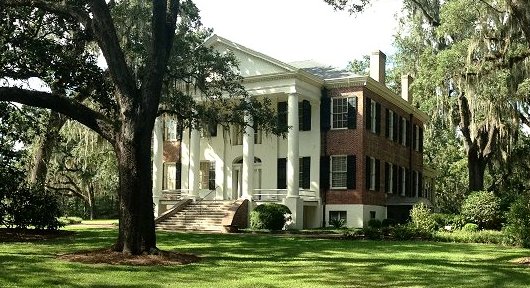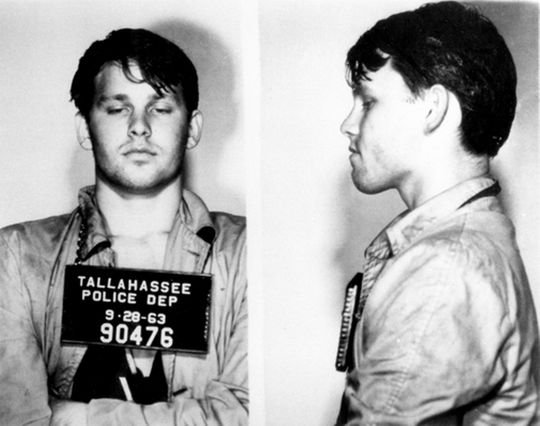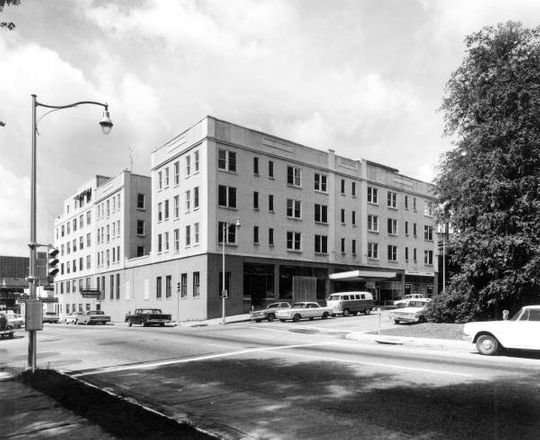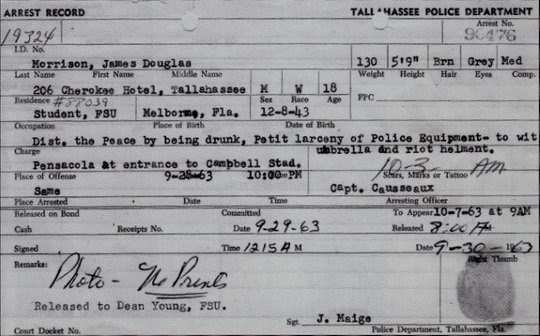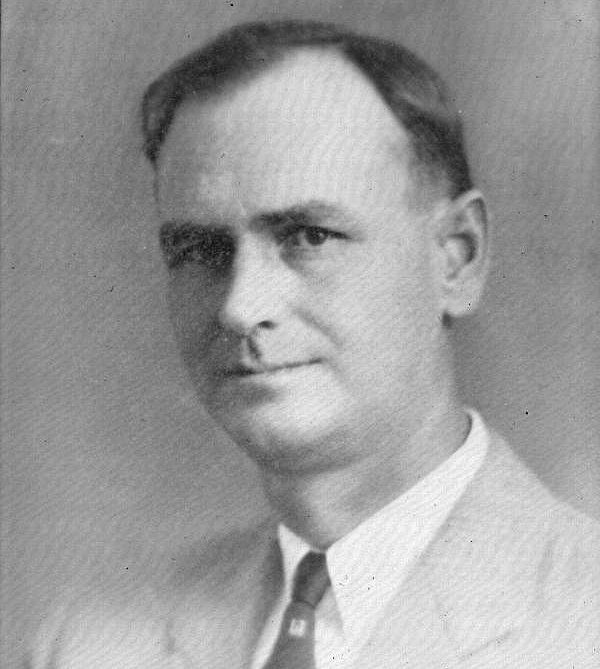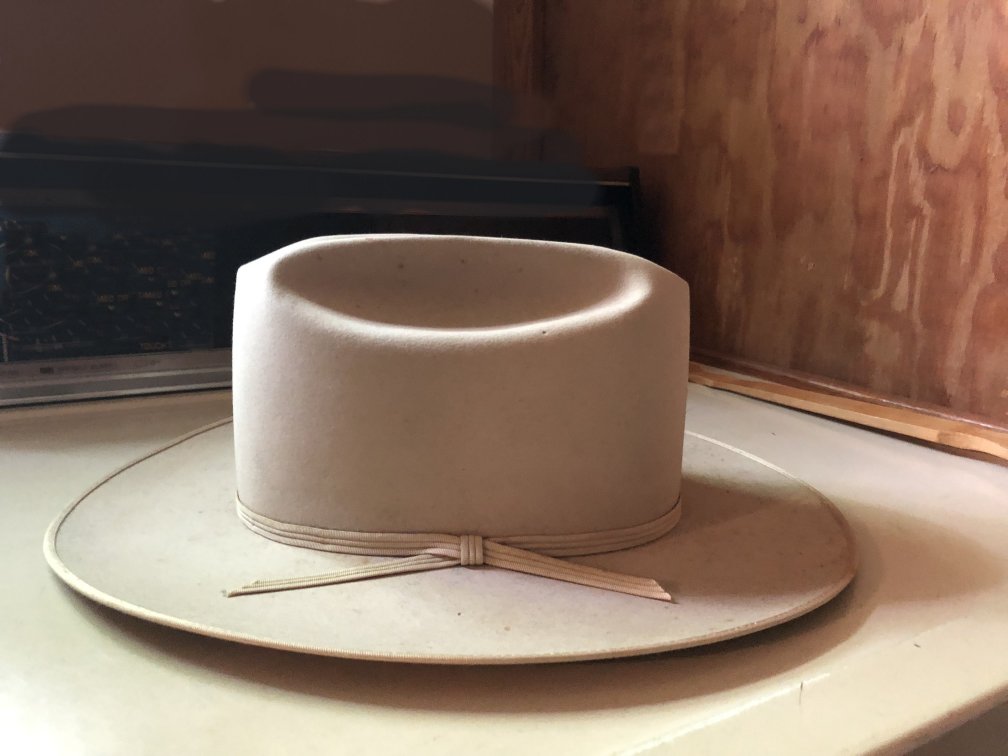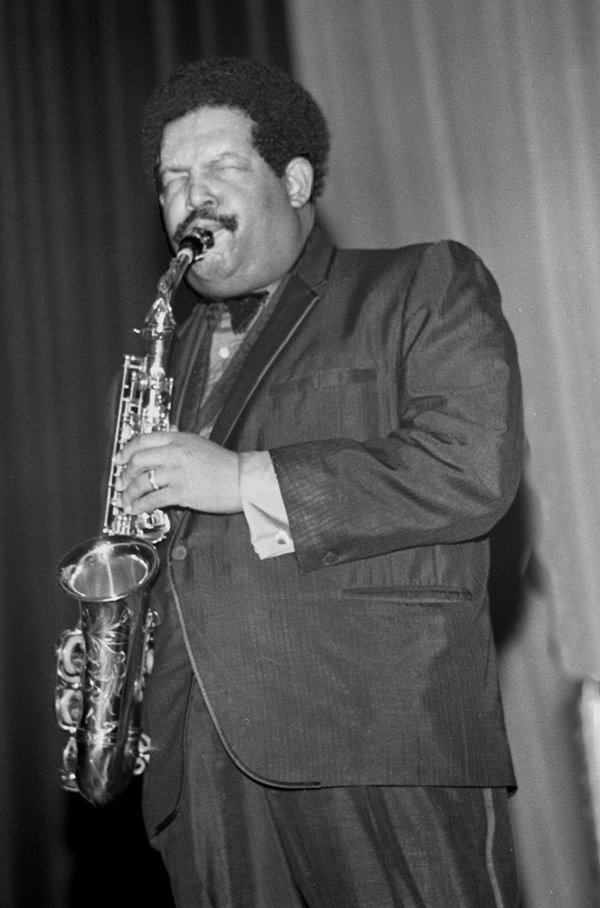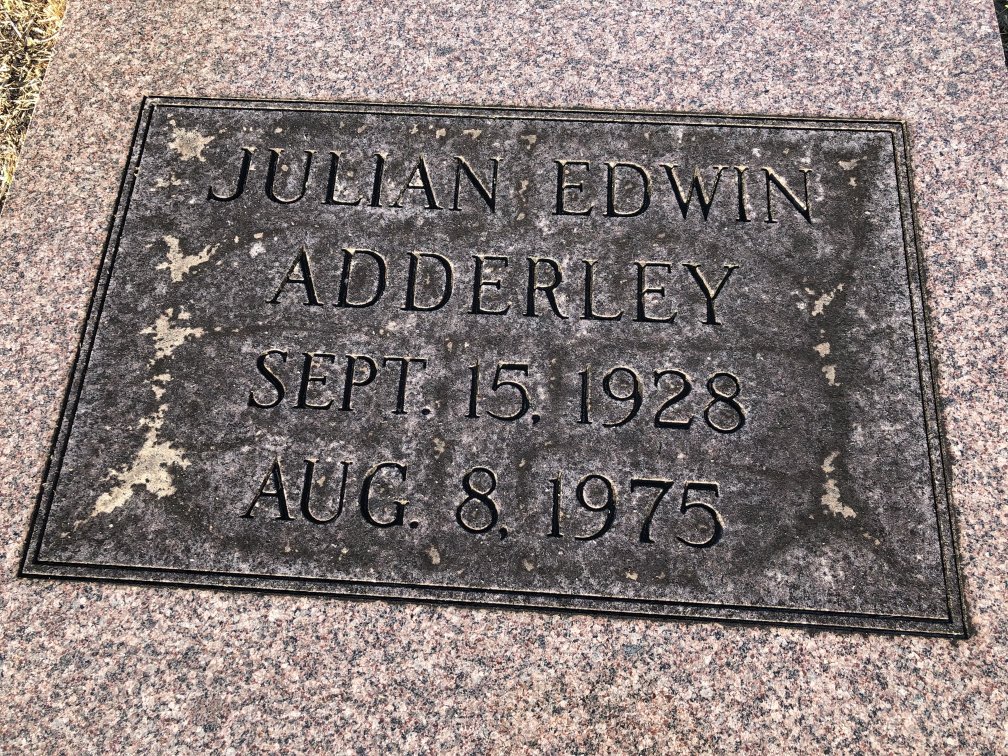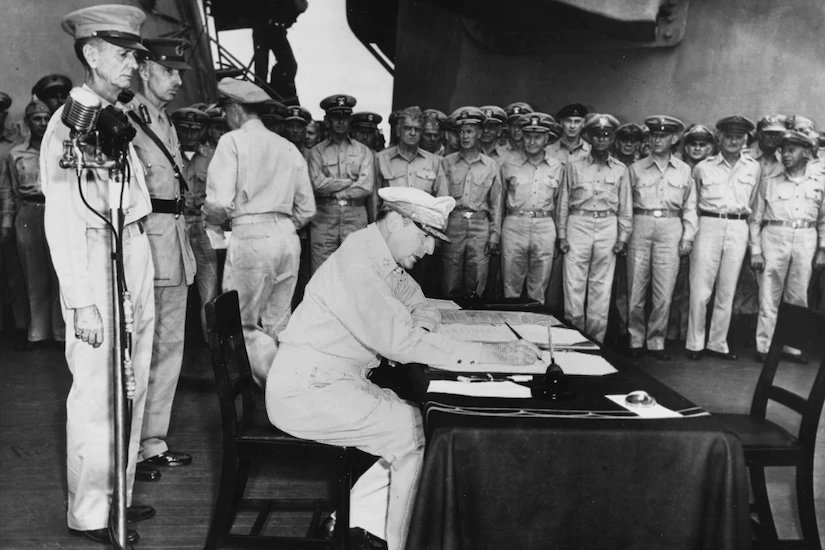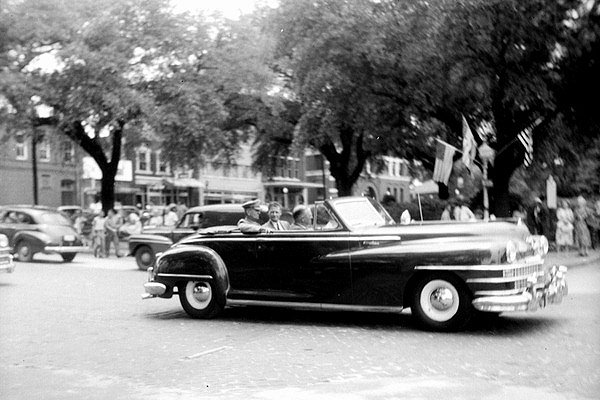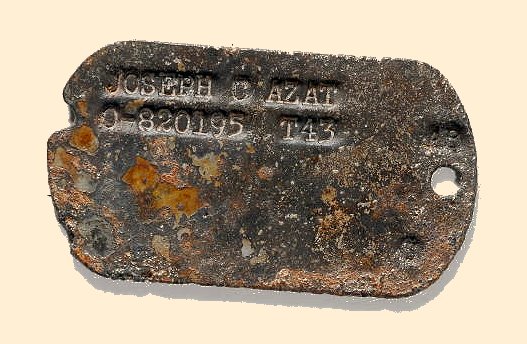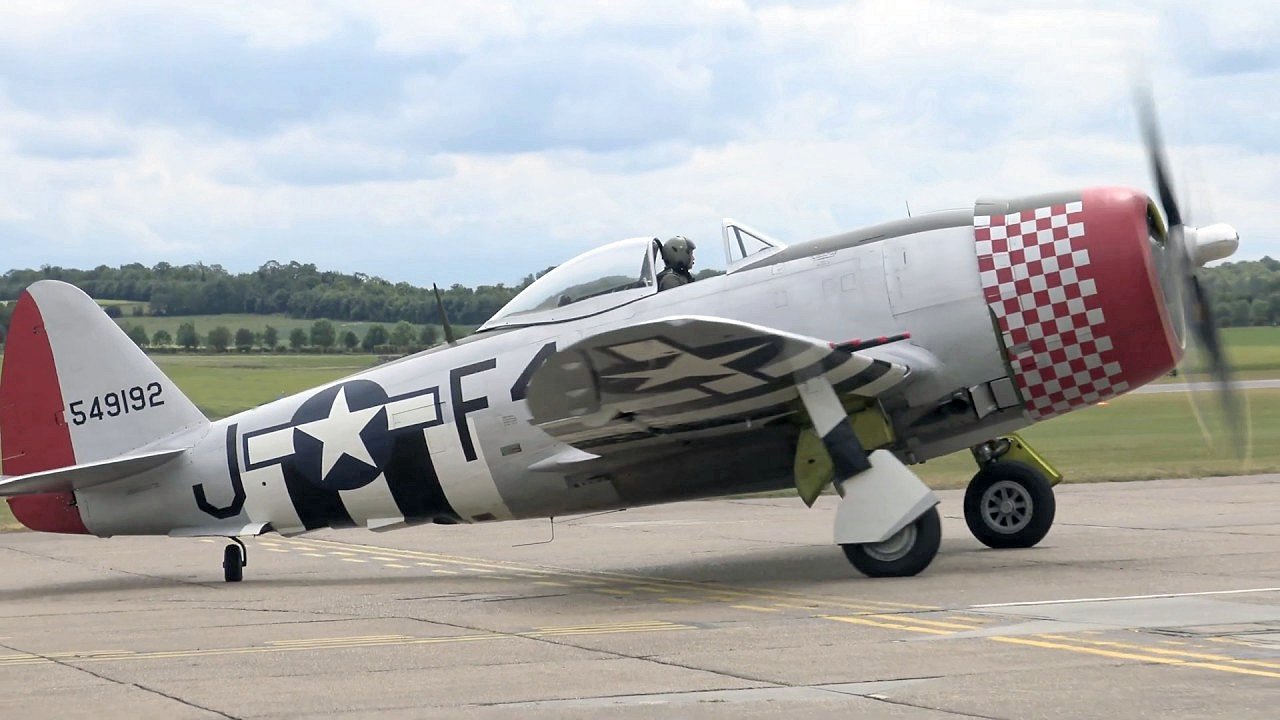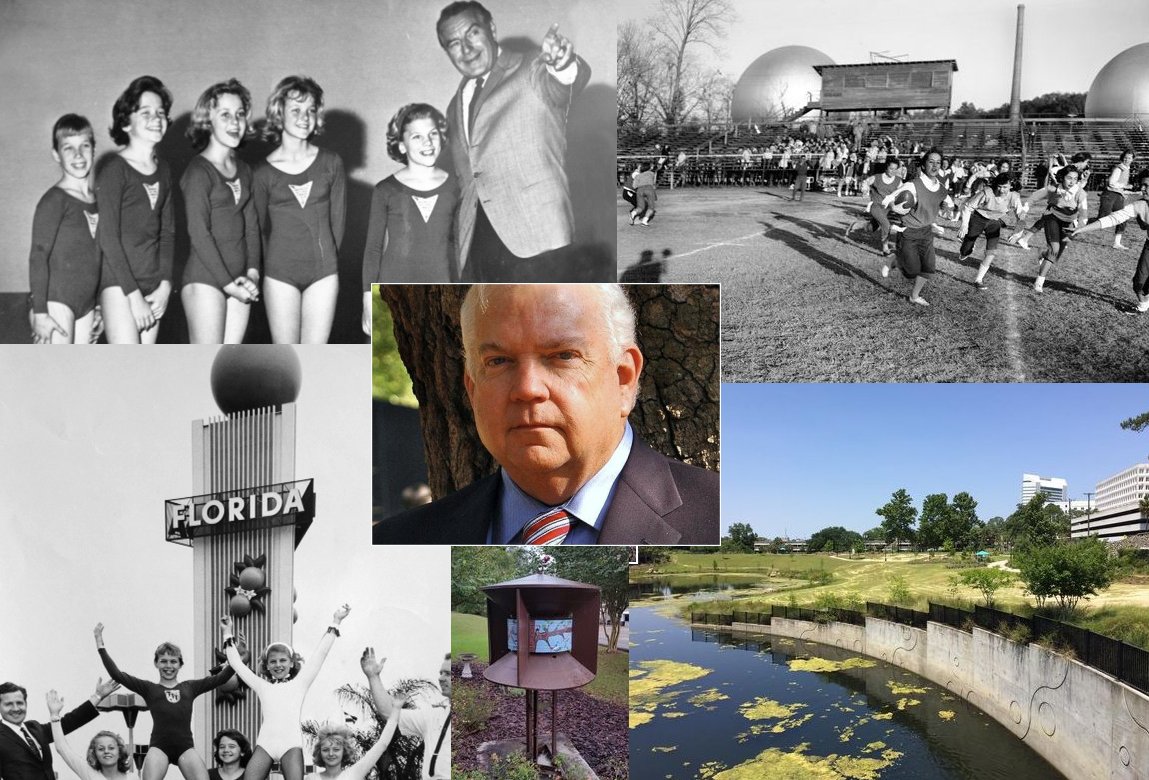
David Brand's
Stories of Old Tallahassee
|
Reflections on growing up along the Cascades When the pioneers who established Tallahassee as Florida’s Capital camped at a stream and waterfall known as the St. Augustine branch, they knew they had found the seat of government for the State of Florida. Never could they have imagined that beautiful Cascades Park would one day be built on that site. My immediate family’s Tallahassee journey began in the Cascades. My parents, both children of the Great Depression, graduated from high school and married in 1937. My dad, George Brand Sr, was hired by the City of Tallahassee and worked at the old utility building; now the site of the Edison Restaurant. One of his responsibilities was maintaining the pumps and mechanics at the old Waterworks Building located at Gaines and Gadsden Streets. Mom and Dad were just teenagers. They had nothing; a borrowed skillet here, a blanket there. They rented a tiny frame “shotgun” house at 814 S. Gadsden St. From their little front porch they could sit and survey the whole area. Their social life revolved around walking to buy their groceries, visiting with family, and occasionally having dinner with the jailer at the Leon County Jail situated across the street. Life was good in a way that can only be understood by young people in love. Dad and his brothers and brothers-in-law went into the army during World War II. After the war he returned to his job with the city. Somewhere along the line dad learned to work a slide ruler, a mathematical instrument from another era, and eventually became the director of what is now called Underground Utilities. The jailer, while never attending law school, apprenticed with a lawyer, stood before the bar and eventually became our state attorney. They truly were our Greatest Generation.
 A Leon High Powder Puff football game in 1959 at Centennial Field. The two gas tanks in the background left the contamination that delayed the completion of Cascades Park for 40 years. (Photo: Florida Photographic Collection) Volumes of Tallahassee kids enjoyed competitive sports and marching band events at Centennial Field which was located approximately where the holding pond is now. Buddy Gridley, a retired lobbyist, Realtor, and my first-grade classmate fondly remembers playing Babe Ruth baseball there for Coach Henry Searcy and was later a member of one of the All Stars teams for Coach Tom Brown. Coach Brown would have them practicing three times a day; in the morning and afternoons with a “skull” session during lunch where they would be lectured on the finer points of the game. Tom Brown Park was later named for Coach Brown. The Springtime Tallahassee activities had their genesis in the Cascades. The festival was originally intended to showcase Tallahassee at a time when the Legislature was considering moving the Capitol to Orlando. Who could forget the venerable and gracious Clifton Van Brunt Lewis butterflying around overseeing those activities. Later, as a Tallahassee Police Motorcycle Officer, I was responding to a traffic crash in the rain and skidded down South Calhoun Street, across Bloxham Street, and right into the stone wall of Centennial Field. I simply couldn’t get the thing to stop on those wet streets. Of course, this was witnessed by several amused state workers. It’s difficult to act like you were actually doing something like that on purpose but I did my best. Also, after the huge propane tanks on the site owned by the city were cut up by welders, the pieces were loaded onto trucks and moved to Florida A&M University, being escorted by my Harley Davidson, where they were reassembled. A few years later I helped pull the bodies of two youngsters out of the ditch that wound through the park after they had tragically been swept away into the storm drain at the Leon High School field. While I was a homicide investigator for years, and no stranger to death, these senseless deaths have always haunted me.
 Centennial Field site, now home to Cascades Park. (Photo: David Brand) These days, one of my favorite activities is to park at the Cascades and walk laps around the park. I always think about my parents, the kids who grew up playing there, Smokey Hollow and all of the events that occurred there. The place literally stinks of history. |
|
Tallahassee Tumbling Tots Prior to 1964, Tallahassee was just another sleepy little town in Florida. We were the Capital City, had two major universities, and Freddie Cannon had even recorded his hit record “Tallahassee Lassie,” but most people around the country had a better chance of throwing a dart at the map and hitting Tallahassee than being able to successfully point it out. In 1964, five young girls in the City of Tallahassee Tumbling Tots gymnastics program changed all that with a series of television appearances and performing at the World’s Fair in New York. The Tumbling Tots concept, training girls in gymnastics, began in 1949 at Florida State University under Dr. Hartley Price and was moved to the City of Tallahassee Parks and Recreation Department in 1959. Training in the old National Guard Armory located on North Monroe Street, the program continued to evolve over the years developing talent at different levels. Members of the FSU Gymkana gymnastic squad provided instruction under the direction of Coach Bob May.
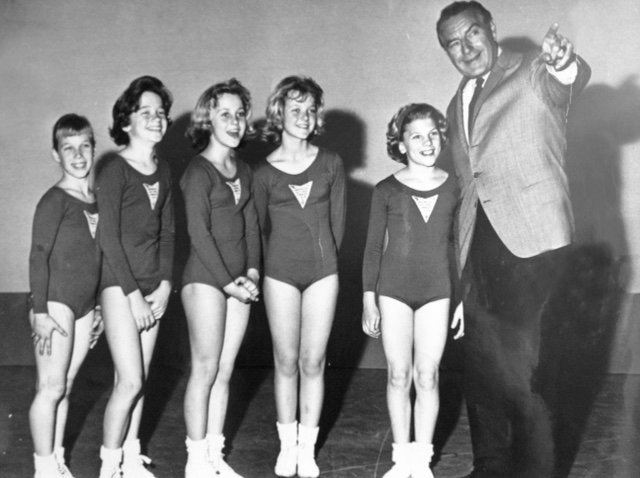 Tallahassee Tumbling Tops on the Ted Mack Amateur Hour television show. (Photo: Photos courtesy of MaryAnn Beaudoin Briggs) The highest-level 1964 team consisted of: Kendall Raker, MaryAnn Beaudoin, Twinkle Freeman, Vicki Freeman and Laurie Becker; all between 11 and 14 years old. David Chapman began his job with the Parks and Recreation Department in 1973 and retired, after a long and rewarding career, as the Director. David relates that around 1970 the gymnastics program moved from the Armory to the lower level of the Northwood Mall. At that time, the Physical Culture Center was established and the program was expanded. David coached at the Center and was instrumental in helping numerous fledgling gymnasts progress in their sport. The expanded program included adults and ancillary programs were developed to serve neighborhoods through the existing Community Centers. Judy Kuhnle is another Parks and Recreation Department member whose career began as a part-time employee while still in the 10th grade in 1968. She recounts that the program was beginning to segue from an acrobatic agenda to a full gymnastics program around 1969. Hard work pays The hard training and commitment led the 1964 team to several nationally recognized appearances. Vicki Freeman (Smith) led a very structured and disciplined life for most of her childhood. Beginning when she was only 4 years old, she trained every day for up to three hours after school with her sister Twinkle. On Friday afternoons they would roll up the three inch mats, stuffed with horse fur, and roll them, along with the other equipment, off the Armory floor. She recalls how this experience occupied all of her free time as a child and taught her the value of hard work. A lifetime later, she still thinks about her experiences and even entertains daydreaming thoughts of performing her old act again.
 Tallahassee Tumbling Tots at the 1964 World’s Fair, held in New York. (Photo: MaryAnn Beaudoin Briggs) MaryAnn Beaudoin (Briggs) remembers first becoming involved with the Tumbling Tots program at Myers Park while watching a demonstration there. She began with twice-weekly classes on the same worn, dusty canvas covered mats as Vicki. After coming home from school, she would do some homework, change into her leotards, and later return from her gymnastics class exhausted. After chugging down a quart of milk, she would finish her homework; a pretty tough regime for a Jr. High School student. For MaryAnn, the team’s appearance on the Ted Mack Amateur Hour television show, a forerunner of “America’s Got Talent,” was surreal. Here they were, five little girls traveling first to Miami for the first appearance and then to New York City for three more and winning each time! The team also represented Tallahassee by performing at the 1964 World’s Fair in New York. Now an avid tennis player, MaryAnn recently attended the U.S. Open Tennis Tournament that is held on the former site of the World’s Fair where she had performed as a teen. One can only imagine the emotions. Life lessons MaryAnn relates that sometimes something comes along in your life’s journey that has a profound effect on the direction your life will take. For her, the opportunity to work hard, perform, and travel was the life-defining experience that became the foundation for her career in the Health and Fitness field as a teacher and coach. She is now a retired teacher and successful personal trainer in Colorado. And so, what began as hard work and commitment by five little girls became a source of pride for Tallahassee and served as an inspiration for others. Dreams do come true.
|
|
When Alligator Point Was Bombed It was a desperate time. The sovereignty of the United States had been attacked and our moral courage had been tested. What was later coined by journalist Tom Brokow as our “Greatest Generation,” rose to the challenge. Following what President Franklin D. Roosevelt described as an “unprovoked and dastardly attack by Japan” the United States, on December 8th, 1941, was thrust into World War II. Suddenly our country was unified around one specific goal; to fight and win. A small and poorly equipped army began to develop overnight and temporary training camps and airfields were built across the entire country. Two notable facilities were Camp Gordon Johnston, located in Carrabelle, Lanark, and St. Teresa Beach, and Male Mabry Field in Tallahassee.
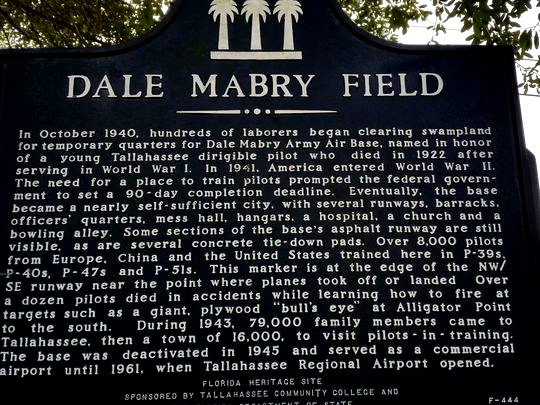 Dale Mabry Field monument. (Photo: David Brand)
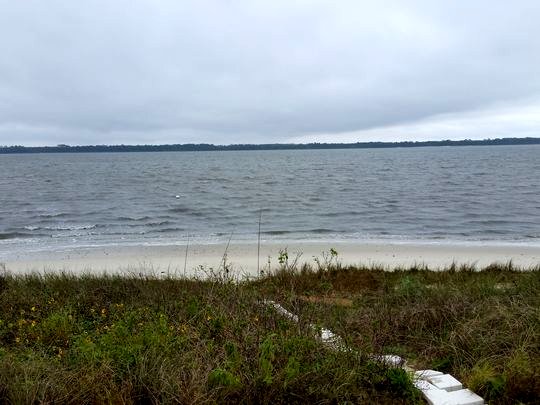 Looking north across Alligator Point Harbor from the exact position of where the target was. (Photo: David Brand) Training fighter pilots is dangerous business. Numerous accidents and crashes occurred around the Big Bend area including at least five on or about Alligator Point. These included a crashed P-39 on October 14th, 1942, a P-40 on January 31st, 1943, another P-40 on April 11th, 1943, a P47 on January 7th, 1944, and another P-40 on June 17th, 1944. About 20 years ago, as the story goes, fishermen snagged their nets on an underwater obstacle in Alligator Harbor. In the process of recovering their nets, the remains of an airplane were discovered. A large, aluminum, liquid-cooled engine was hauled up and placed on the shore of the bay. Given time and hurricanes, the engine was once again buried taking its secrets with it. And so, the next time you are cruising down Alligator Point enjoying the natural beauty, take a few minutes to reflect about its past and the part it played in ensuring the safety of our great nation.
|
|
Remembering the days of duck and cover The world had become a scary place. Air raid sirens and Geiger counters were commonplace but children, in their innocence, accepted it all in stride. After all, the late 1950s was a period of prosperity where the United States had emerged as a first rate world power after World War II and everyone “Liked Ike.” But, with the very real possibility of the entire country being incinerated in a nuclear attack, was there ever really a plan for what would have come next?
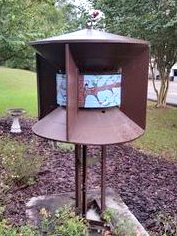 Air Raid Siren (Photo: David Brand) Thousands of bright yellow Civil Defense air raid sirens were placed in cities. Periodically, they would be tested and you would hear the low, growling sound begin as the sirens wound up eventually reaching a high-pitched screeching sound. Had it been for real, this would have been the Doomsday sound. One of these sirens, now an aging symbol of the Cold War era, can be seen in front of the Senior Citizen Center on North Monroe St. It no longer shouts out with a bright yellow warning but is now painted a subtle, calming brown trimmed with birds perched on branches. Another part of the warning system involved the Conelrad band on AM radios. If you can locate an AM radio manufactured in the ‘50s or ‘60s you will notice two small Civil Defense triangles at the 640 kHz and 1240 kHz positions. These would have been the stations that broadcast civil defense information during a nuclear attack. Just imagine trying to get something like that accomplished today; it would be stalled in Congress for years. However, there was never any viable plan for what to do after the attack. Black and yellow Civil Defense Fallout Shelter signs were placed strategically around the city; mostly on the bottom floor of large state buildings. These were designated as places for citizens to go in the event of a nuclear blast; or, at least for whoever would have been left. Even I, as a child, couldn’t help but think that the large buildings would probably have been at ground zero anyway because there was no other target worthwhile to bomb in Tallahassee. Ed Borneman, a long-time resident, worked summers during high school in the late ‘60s for the City of Tallahassee Civil Defense Department. His job was to fill plastic lined cardboard drums with water, carefully adding a determined amount of bleach, and placing them in the designated public Fallout Shelters. The water, along with crackers, high-protein candy, and limited medical supplies comprised the minimum requirements to sustain life during the weeks that the occupants would remain inside the shelters. Some folks, who were probably the forerunners of what we now call Doomsday-Preppers, built home fallout shelters. These were mostly bare-bones concrete block structures buried underground in backyards. A simple, hand crank ventilator system pumped in fresh air from the outside. It had a filter, that was supposed to eliminate “most” of the nuclear fallout debris, but no one really knew if it would work or not. A few of these fallout shelters can still be found; long since turned into root cellars and little boys’ forts. Then came the Cuban Missile Crisis in October, 1962, when President Kennedy faced down Soviet Premier Nikita Khrushchev over inter-continental ballistic missiles being placed in Cuba; a mere 90 miles from the shore of Florida. The threat in Tallahassee reached near critical mass as convoys of soldiers from U.S. Army forts in Georgia and Alabama drove through the city on their way to the Florida Keys to marshal. Historians generally agree that this was the closest that we came to a nuclear war. And so, when I begin to think about the economy, the dysfunctional Congress, and so many other issues with no apparent plan for resolution, all I have to do is reflect back on the Duck and Cover drills and they pale to insignificance.
|
|
The wonderful nostalgia of pre-theme park Florida. Florida was a wonderful place to grow up in. We had mermaids who smiled at you from their underwater theater, dolphins that leapt for treats from their concrete tanks, regional curiosities, fish that would almost jump into your boat, sunny beaches, and the best of all the best, spacemen. Then came Mickey Mouse.> I’m a fifth generation Floridian who, after retiring from two different law enforcement careers, began a third career with a non-profit supporting law enforcement. Representing clients requires a lot of traveling about the state almost always by car. Recently, I found myself standing at the intersection of U.S. 19 and Cortez Boulevard in Hernando County gazing down at the Weeki Wachee State Park reflecting on its famous history as a tourist destination before the huge theme parks diverted our state’s visitors to other areas. Susan Backlinie, the actor who played the beach girl character “Chrissie” who was eaten by the shark at the beginning of Jaws, got her start there in the mermaid show! That was when I realized that the “Old Florida” was still there to be enjoyed if our visitors wanted to get off of the beaten path. > > The purpose of this article is to highlight some of the former tourist destinations and off the beaten path curiosities of Florida when the family car vacation was king and the two-lane highway was the only route. In order to do that I'm going to take you down some of the old secondary Florida roads that are still littered with fruit stands and mom and pop restaurants. Yankeetown This sleepy little fishing village, located off of U.S. 19 in Levy County, had a brush with celebrity during the summer of 1961 when Elvis Presley, Elvis the Pelvis himself, filmed the movie Follow That Dream there. It was one of the first of several cookie cutter movies that he made with what would later become the predictable girl falls for singing boy while he fist fights his way through bad guys formula. Weak screen writing but fairly good acting aside, the movie developed an almost cult following that boosted the tourist economy of the area for years before fading into history. Most of the movie was filmed where a branch of the Withlacoochee River spills into the Gulf by the Bird Creek Bridge. I’ve walked through much of the site where the movie was shot. It’s now overgrown with palmetto bushes and vines of every description. The first thing that you notice is the heavy smell of salt air riding on the balmy breezes coming off of the Gulf about a mile away. Before production began, the area around the water’s edge was bulldozed and truckloads of white beach sand and palm trees were hauled in to make the area attractive on the silver screen. Of course, this is something that simply couldn’t be done today without running afoul of countless environmental protection laws. The movie had such an impact on the local community that the highway leading out to the filming site was named “Follow That Dream Parkway.” These days, local anglers dangle their hooks off of the Bird Creek Bridge unaware of its past history. Weeki Wachee Springs Weeki Wachee Springs, located on U.S. 19 at County Road 50 in Hernando County, is noteworthy as it was one of the most famous tourist attractions before super highways were built leading directly to the huge theme parks in the Orlando area. In 1946 Newton Perry, a former World War II Navy diver, saw the spring which at the time was filled with old refrigerators and cars. He cleaned it out with the vision of creating an underwater show. The spring, which produces 117 million gallons of 72 degree water a day, was a natural theater. The first show, with mermaids recruited from local girls and trained by Mr. Perry, was on October 13, 1947; one day before Chuck Yeager broke the sound barrier. It was an instant success but had few visitors. To remedy this, the “mermaids” would get in a line on the side of U.S. 19, wearing their swimsuits of course, and wave at passersby. Apparently, this time proven method of advertising worked. The movie “Mr. Peabody and the Mermaid” was filmed there in 1948 bringing more much needed publicity. The underground theater was remodeled with the seating capacity increased to 500 seats in 1959. By the early 1960s, young women from all over the world were competing to become mermaids in the show. Cashing in on the success of the theater, the television series Route 66 filmed an episode at Weeki Wachee in April of 1963. The television series was about two free spirits, Tod Stiles and Lincoln Case, who drove the length of Route 66, “the mother road,” from Chicago to Los Angeles looking for adventure. At some point in the series they must have run of out interesting places to film and came to Florida. The episode, entitled “The Cruelest Sea of All,” had the boys taking jobs at Weeki Wachee long enough to make enough money to continue with their travels. The character Tod worked as a “merman” whose actual duties involved performing tasks behind the scenes to support the mermaid actors. But, there was a real mermaid among the actors. Or, was there? The spring water, boiling up at a tremendous rate, eventually empties into the Gulf a few miles away. The water in the river is so clear that you almost can’t see it. When the sun is shining at a certain angle it actually looks like the river is dried up with the white sand bottom curling back and forth through the woods. Manatee, a warm blooded mammal that is a protected species in Florida, gather in the river that leads to the Gulf to enjoy the warm water during the winter months. Folklore has it that ancient sailors saw manatee in Florida waters and thought they were mermaids further adding to the mystic of the area. The sailors must have been at sea for a long time … . The Ringling Circus Museum The Ringling Circus Museum is located at 5401 Bay Shore Road in Sarasota. Sarasota became the winter home of the Ringling Brothers and Barnum and Bailey Circuses in 1927 when the circus was in its heyday. Since the winter weather conditions were too harsh in most of the country for shows that appeared under a tent, the circus would cease their tour and take their performers and animals to a warm place to spend the winter. Railroad tracks were laid specifically to transport the circus train from the regular route to the Sarasota encampment. The railroad tracks have long since been removed and replaced with a “Rails to Trails” bike path that the author has personally ridden from Sarasota to Venice Beach and back. There has been a long-standing symbiotic relationship between the Ringling Circus and the Florida State University Flying High Circus. For generations, the FSU circus as the only college circus program in the country, was a feeder school for the Ringling Brothers circus. High-wire flyers and performers would take the skills that they learned performing before live audiences and apply them to their later careers in sales, management and even law enforcement. In 1948 John and Mable Ringling built the spectacular Ringling Museum of Art on the circus site. With its art collections and cultural exhibits, the museum became, and still remains, a popular Sarasota attraction. One of the features is the “Wisconsin,” the personal railroad car that John and Mable lived in while touring the United States with the circus. They were the Rock Stars of that era. Visitors can see performers’ wardrobes, equipment and hand carved circus parade wagons that were pulled by festooned horses. The impact of principally two events resulted in the decline of visitors to the Ringling Museum: the decline of the circus as a form of entertainment and tourists wanting to see high-tech exhibits. Gibsonton If interested, you can scoot around Tampa Bay on U.S. 41 and drive through the tiny hamlet of Gibsonton. The reason it was created and the reason why it faded away are fascinating. During the Great Depression of the 1930s carnival and circus people, many of whom traveled with Ringling Brothers Circus, lived there during the winter off-season. Back then, the side-show performers and “freaks” such as the bearded lady and the reptile man were the stars and high-earners of the carnival. In some communities they would have been social outcasts but in Gibsonton they were considered regular folks. Al Tomaini, the eight and a half foot tall giant, and his 24 inch tall wife Jeanie, developed a trailer park and fish camp on Tampa Bay, still known locally as the “Giant’s Camp,” in 1949. Al also served as the police and fire chief during the 1950s until his death in 1962. My guess is that it would have taken an almost nine foot tall man to control the likes of Lobster Boy and the Alligator Man who were not used to the normal conventions of society. While the freak shows have been replaced by games and rides, carnival folks still live in the area with their travel trailers, exotic animals and cotton candy machines ready to hit the road during the warmer months. This is definitely the land that time forgot. You can feel yourself being watched as you ride around. This is their place, not yours. Cypress Gardens In days gone past, when there was a demand, the famous Orange Blossom Special train took tourists all the way to the end of the line in Polk County Florida to see the famous Cypress Gardens. Dick Pope, who in his earlier career had barnstormed around the country putting on speedboat shows, saw the potential for a botanical garden on the shores of Lake Eloise in Polk County. He was able to convince the WPA to dig out canals in 1936 creating another lake for his newly named Cypress Gardens. During World War II, a newspaper published a photo of a pretty young woman water skiing on the lake. Soldiers from nearby training camps flooded the Gardens hoping to see more. From this serendipity the water ski show was born creating one of the most popular tourist attractions in Florida. However, by the time that Walt Disney World opened in 1971, highway routes and visitor demographics had begun to change and attendance dropped. Instead of water skiers, it seemed like everyone wanted to see the Mouse. The gardens changed hands several times but never regained the fame of its past. While the water ski acts are no longer performed, the new Legoland Park sits on the same site. Marineland of Florida Marineland of Florida is located on the Atlantic Ocean south of St. Augustine. As is often said, nothing lasts forever. Marineland was originally developed as an aquarium where marine life could be studied and visitors charged admission to finance it. When it opened on June 23rd, 1938, Highway A1A, later made famous by singer Jimmy Buffett, was clogged with over 20,000 unexpected tourists. Dolphins were trained to jump and whales begged for food to the delight of the crowd. This was Florida’s first large scale marine show. Some scenes from the movies “Creature from the Black Lagoon” and “Revenge of the Creature” were filmed there in the 1950s. Most of the scenes from “Creature from the Black Lagoon” were filmed at Wakulla Springs in Wakulla County, Florida. Ricou Browning, who played the role of the creature wearing a horrible rubber suit and later went on to pioneer underwater cinematography, was actually a life guard at Wakulla Springs and for the City of Tallahassee while attending Florida State University. As a life guard for the City of Tallahassee swimming pools he gave swimming lessons to local children including the author. So, one of my claims to fame is that I was taught to swim by the “Creature from the Black Lagoon.” When SeaWorld opened in the 1970s close to the Disney properties, attendance dropped to almost nothing as the crowds of tourists drove straight to the Orlando area via the unclogged I-75, Florida Turnpike corridor. After struggling for years, Marineland was re-designated the Marineland Dolphin Adventure in 2011 and offers swim with the dolphins experiences. Cape Canaveral From the time that the original Mercury astronauts were selected in 1959 through the Apollo program of the early 1970s, Cape Canaveral was not only a must-see for tourists but a staging area for the news media. The whole world watched as Alan Shepard blasted off into space for the first United States sub-orbital, or as it was billed the first “free man” in space, flight on May 5th, 1961. President John Kennedy’s proclamation that we would have a man on the moon by the end of the decade guaranteed funding for the Apollo program. When Astronaut Neil Armstrong stepped out of his spacecraft and onto the moon on July 20th, 1969, President Kennedy’s vision was fulfilled. Cape Canaveral was deluged with tourists, all wanting to see where it all happened. Then came the Mouse. Like everything else, what is new now will eventually become old and faded and still another generation will be lamenting over their lost youth. |
| Remembering Tallahassee’s Drag Strip Drag racing, once banished to lonely country roads with spectators donned in leather and denim, began to come into its own in the mid- 1960s. While dangerous and unlawful races were still being conducted on then remote streets like Mission Road, a sanctioned drag strip was built on west Highway 20 in Leon County. It was a transitional time in Tallahassee. The carefree attitude of the early 60s was changing on several levels. Mini Skirts were replacing ladies’ hats and gloves, men began leaving their fedoras in the closet, music was segueing from snappy to the surreal, and small Japanese motorcycles were outselling American made Harley Davidsons with the ubiquitous Honda 50 seemingly everywhere. And muscle cars ruled the streets. The movie “American Graffiti” could have been filmed on West Tennessee or South Monroe Streets. Cars cruised back and forth with the muscle cars, the Pontiac GTOs, Dodge Chargers, and Ford Mustangs sniffing around each other much like stray dogs trying to establish the pecking order. On the peripheral were the Volkswagens and Ford Falcons, the Wannabes, circling the pack hoping to see some action. Then there was the outer perimeter; the Hopefuls. This was the younger set with their Vespa scooters and Honda Cub 50 motorbikes. Here, the pegged denim and chino pants gave way to baggy jeans with rolled up legs and Buddy Holly black framed glasses. The Hopefuls, much like pilot fish, gathered closely waiting anxiously for a nod of acknowledgement from one of the cool guys or maybe even from a Falcon driver. Many of the hot rodders gathered at Smith’s American Service station on South Monroe St. on weekends and evenings to talk cars. According to Tallahassee resident Greg Wood, a member of the racing inner-circle, Dave Youngman was the acknowledged authority of all things racing. Having followed the racing circuit, Dave knew about cars, the drivers, and the sanctioned rules. For the amateur racers, it usually went something like this. One of the “leaders of the pack” would be backed in at a drive-in restaurant, maybe the Dixieland or Corral on South Monroe Street or the Seven Steers on West Tennessee Street. The Volkswagen Beetles and Falcons waiting patiently on the outskirts of the parking lot. A rival, or maybe even an out-of-town hotshot, would ride through, eye contact was made, and the race was on. A convoy would form, with a Falcon pulling up the rear of course, and head out to one of the country roads for the race. Afterwards, providing there were no mishaps, everyone would return to the drive-ins, hands were shook, stories were told, reputations reaffirmed, and even the little guys in the Falcons were allowed to join in. In retrospect, the potential for tragedy is difficult to measure. A sanctioned drag strip was built on west Highway 20 in Leon County in the 1960s. (Photo: David Brand) In the mid-60s, Herb Chanel, the owner of the popular Chanello’s Pizza on West Tennessee Street, had a vision of developing a drag strip in the Tallahassee area. His vision came to fruition in 1966 when he built the Tallahassee Speedway Park on land he owned on Highway 20 West in Leon County. Dave Youngman, the obvious choice, was hired as the general manager. Much like bass fishermen would travel from afar to fish in Lake Jackson, drag racers flocked to Tallahassee. For the first time, young folks had a safe place to pursue their passion. Suddenly, muscle cars began to appear at Frisch’s Restaurant and McDonalds on West Tennessee Street after the races with the white chalk race sequence numbers still painted on their windshields – a definite status symbol. All boasts and arguments had been settled on the strip, discussed, and friendships reaffirmed. Brandon Wood, Greg and Patsy Wood’s son, inherited his dad’s love of cars and racing. As a professional race driver, he won the Jeg’s Allstars Race, an officially sanctioned event, in Columbus, Ohio in 2001. Today, he still drives and races cars for other owners throughout Georgia. And then it was over. Pegged pants gave way to bell bottoms, Flower Power was the slogan of the day, and muscle cars were replaced by Volkswagen buses with flowers painted on the sides. The thunder of hemi-head V-eight engines with glasspack mufflers was no longer heard. All things change and as Thomas Wolfe wrote in 1940, “You can’t go home again.” Oh, and by the way, I had a Falcon. |
| Remembering Wilson’s Beach Cottages When Captain Mitsuo Fuchida, of the Imperial Japanese Navy 1st Air Fleet, released his ordinance on December 7th, 1941 at Pearl Harbor it set into motion a sequence of events that eventually contributed to the creation of Wilson’s Beach Cottages at St. Teresa Beach.
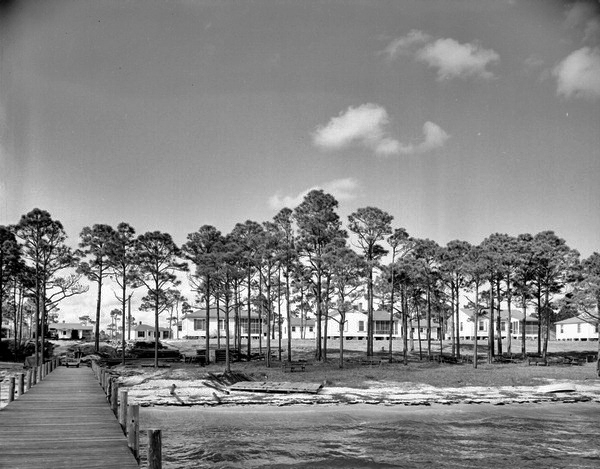 Wilson's Beach Cottages, probably from the early 1950s. (Photo: State Archives) Wilson's Beach Cottages, probably from the early 1950s. (Photo: State Archives)
Camp Gordon Johnston At the beginning of World War II, when Army planners realized that amphibious landings would play a significant role in the invasions in two theaters of war, they began to look for a place with a jagged coastline, hard beaches, and off-shore islands. Settling on the coastline in Franklin County, Camp Gordon Johnston was established with training ranges and barracks situated in Carrabelle, Lanark, and St. Teresa. The training areas included rifle ranges, hand grenade ranges, and even a mock up German Village named “Shickelgruber Haven” close to Carrabelle. The Headquarters, which had the unheard of luxury of an outdoor theater, was located at what is now the Bay North gated community. An asphalt parade ground, water tower, and rows of hastily constructed tar paper billets were located directly north of U.S. 98 from the Headquarters area. The training was tough and the living conditions even tougher. One can only imagine sitting at that outside movie theater trying to concentrate on Humphrey Bogart lamenting to Ingrid Bergman about how they would “always have Paris” in 95 degree heat while swatting at those famous St. Teresa mega-mosquitoes. General Omar Bradley, who eventually commanded all allied troops in Operation Overlord, the invasion of Normandy on D-Day, brought the 28th Infantry Division to Camp Gordon Johnston for training. After enduring the harsh living conditions, he famously remarked “the man who chose this place ought to be court martialed!”
The old Army barracks were repurposed as Wilson's Beach Cottages at St. Teresa in the 1960s. Wilson’s Beach Cottages When Camp Gordon Johnston was created, the government leased thousands of acres from the St. Joe Paper Company and other private land owners. Barracks, an Army term for living quarters, warehouses, administrative buildings, and an infirmary, along with all the infrastructure to support the camp were constructed. Three docks were also built at St. Teresa to tether the amphibious landing craft that the soldiers were training for seaborne invasions in. Two were built at the Headquarters area and a third built west of those further down the beach. When the Camp was decommissioned in 1946, after the war was over, 37,000 acres, along with hundreds of buildings, were returned to the original land owners. In the late 1940s and early 1950s, some of the abandoned buildings were cut up, moved and reconstructed along the beach as vacation homes. Some were situated along the periphery of what became the village of houses comprising Wilson’s Cottages with the centerpiece attraction being the dock that had been built by the Army Corps of Engineers. Additional rental cottages were constructed in cookie-cutter fashion with rolled asphalt roofing and shingled or clap board siding with two small bedrooms, one bath and a tiny kitchenette. Making Memories With powder white sand, laced with seaweed, the beach was a welcome sight to droves of folks from Georgia and elsewhere who traveled there for an affordable family vacation. There was even a small general store by the highway that sold, in addition to milk, bread, and other food, gallons of “sun tan lotion,” for the guests who were ill prepared for the what the sun could do to them in a mere thirty minutes. When Jimmy Buffett wrote the lyrics “stepped on a pop top” it applied to St. Teresa just as well as Key West. Between the pop tops that had been carelessly tossed into the sand, along with the occasional catfish skeleton, many out-of-state guests had their vacations ruined by a trip to the emergency room that generally required a journey to Tallahassee. But even with these distractions it was still a wonderful place to experience the real Florida. Dale Jones, longtime Tallahassee and St. Teresa resident, remembers the huge Leon High School Spring Break parties at Wilson’s in the early and mid-1960s. For the kids, it was paradise. For the parents, it was actually a very safe place to go with no traffic and no predatory behavior because everyone knew each other. After all, St. Teresa was and still is something of a secret place. All good things end. Wilson’s Cottages no longer exist. The area is grown over now just like the remains of Camp Gordon Johnston. The only remaining cottage has been vacant for years with Mother Nature sending her vines to grow on the walls and harsh weather to erode the exterior. Even now, if you stand on the beach where Wilson’s Cottages used to be and close your eyes you can visualize the amphibious landing craft, filled with soldiers from all over the country, going back and forth with the ebb and flow of the sea on training missions, while at the same time almost hear the gleeful shouts of kids a couple of decades later as they visited the Gulf making memories with their families. |
| Remembering Red & Sam’s Fish Camp Red and Sam’s Fish Camp, located on Lake Jackson, was once a favorite destination for Bass Anglers from all over the country. For southern males, fish camps are not simply a place to buy crickets but absolute Nirvana.
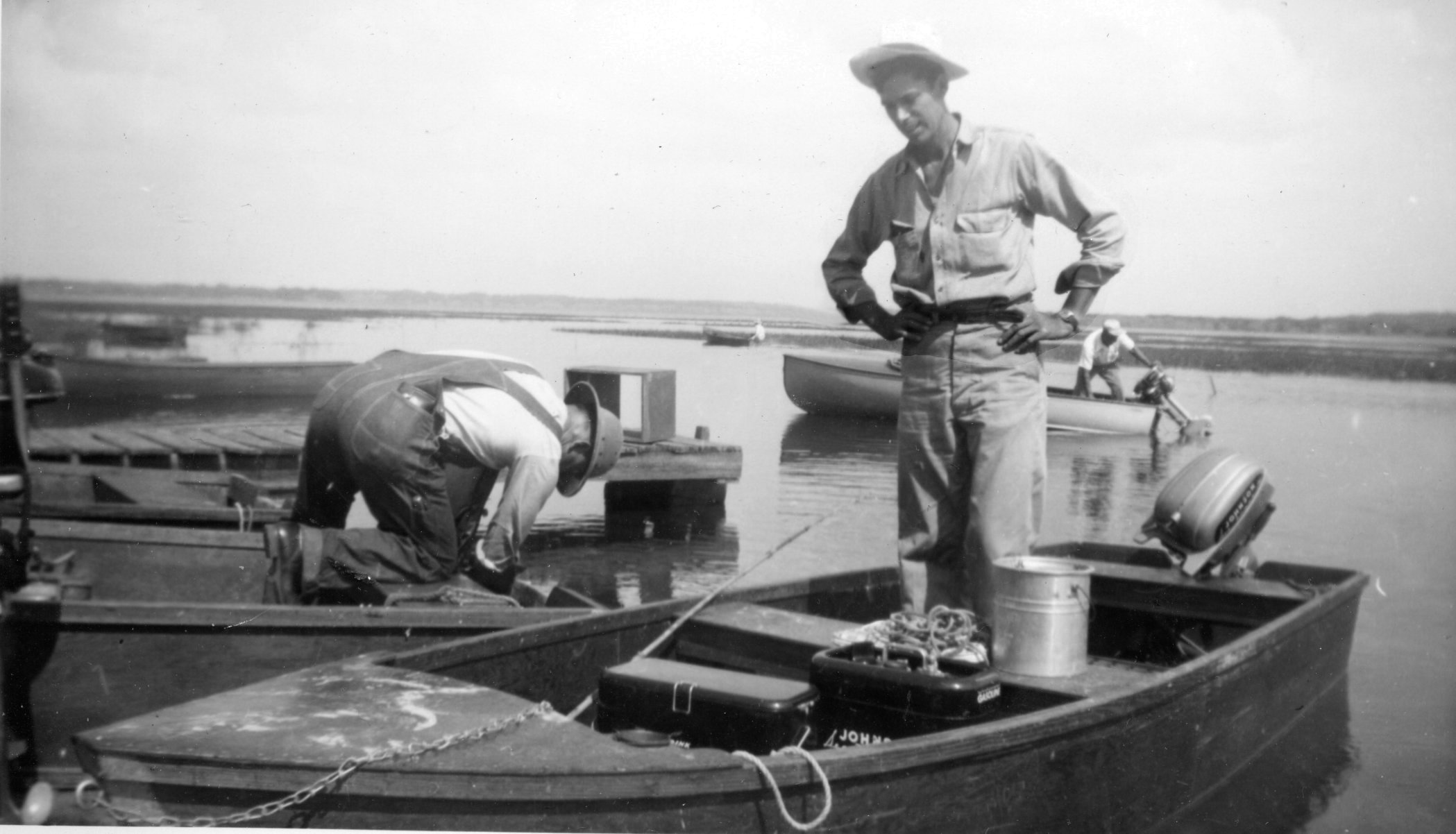 Putting in at Lake Jackson, August 1950
Lake Jackson is a shallow lake, sometimes referred to as a prairie lake, on the northside of Tallahassee. The lake covers about 4,000 acres with the lake basin extending far beyond the normal water level. It has long been recognized as a productive fishing lake bearing Largemouth Bass and a variety of Bream among other species. It’s also somewhat mysterious as the water has been known to disappear every 25 years or so.
Like much of Florida, Tallahassee sits on top of limestone that is riddled with caves and caverns forming the aquifer. During times of drought, the lake level will drop and the water in the delicate aquifer beneath will drop as well. Over a period of days, the lake will drain into the aquifer just as if a huge toilet was flushing carrying some of the lake detritus with it. This phenomenon must have been especially frightening to the Native Americans who occupied the southwest shore of the lake by what is now the Jackson Mounds Archaeological State Park.
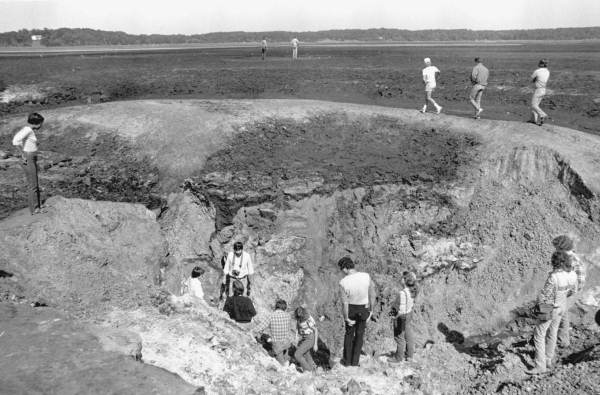 In 1982 Lake Jackson drained through Porter Hole Sink, leaving only isolated pools. Red and Sam’s Fish Camp, owned by Red Smith and Sam Crowder, was originally located at the end of Crowder Road on property that was owned by the Crowder family. Situated on the southside of Crowder Road, by what is now a Leon County Boat landing, it was close to the productive Meginnis Arm branch of the lake. Later, the camp was located on the Northshore west of where the J. Lee Vause Park is now. This is the site most of “Old Tallahassee” remembers. It had a bait and tackle store that always seemed to have clientele hanging around sipping beer, discussing fishing lore, and whispering about their secret spots. The most closely guarded tales involved where cotton seed meal bags had been strategically placed to create catfish beds. 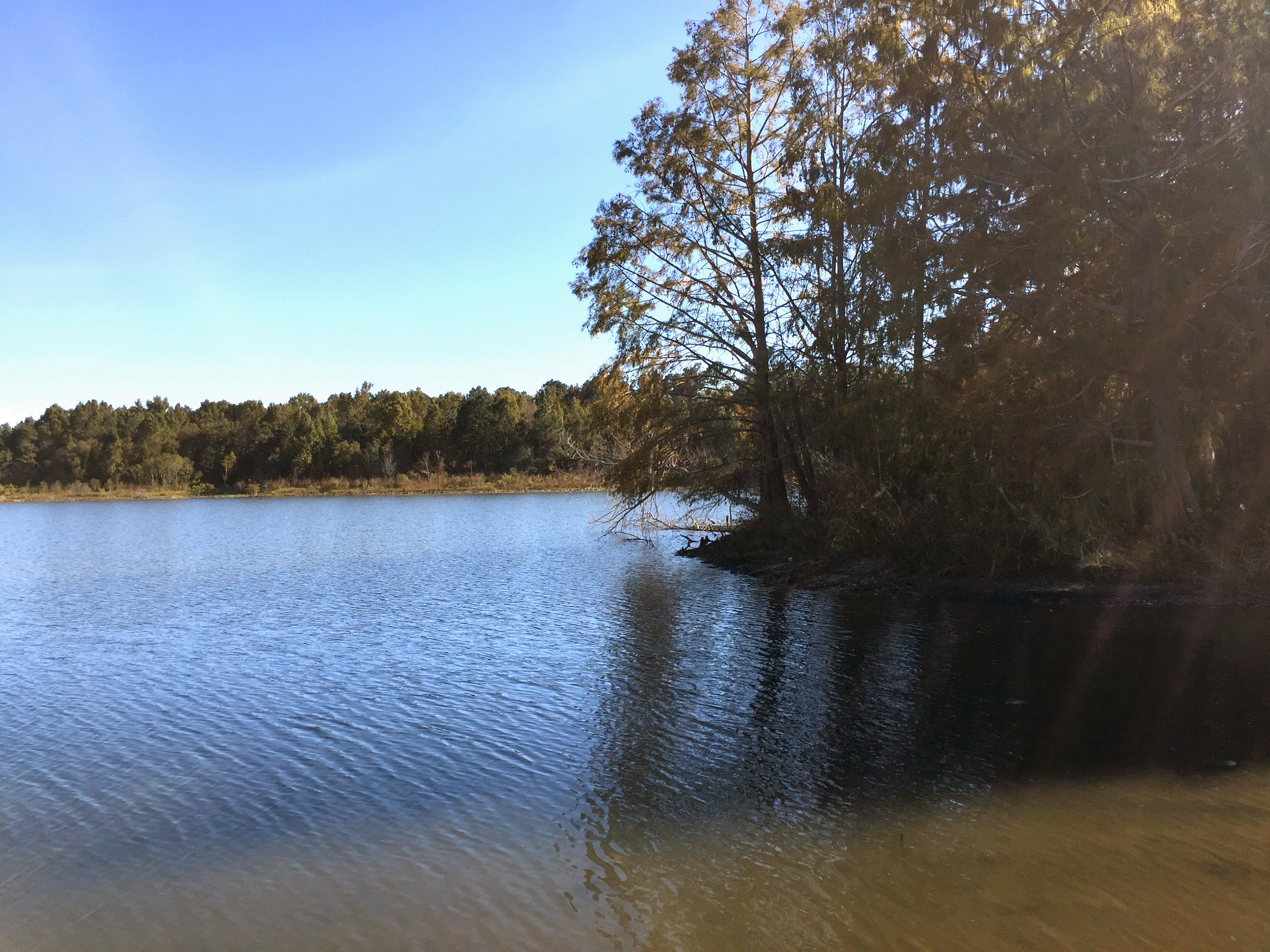 Lake Jackson (photo by David Brand)
Now, what you must understand is that fish camps are to southern males what huge shopping malls are to women. They are not just a destination but a place to be seen and watch others. And maybe, to a certain extent, to show off a little. At the first stratum are the cane pole fishermen. I have many fond memories as a boy fishing with a cane pole and frying panfish in an iron skillet over a campfire on the shore of Lake Jackson before the area became overgrown with homes. The next social level consists of those with small boats; usually jon boats with small outboard motors. In many respects those are the best for the shallow water of the lake and can always be seen skimming about along the peripheral. My older brother, George, once had a wooden jon boat with a small outboard motor. It was loads of fun until one winter the tiny engine vibrated the entire stern off sinking the boat in ice cold water in seconds. At the top of the heap are the fast boats with tremendous engines and state-of-the-art electronics.
In the fall, Red and Sam’s ushered in Turkey Shoots. This is an especially southern tradition that originally involved live turkeys. Turkeys were kept in a confined area and then released. As they fluttered about they would be shot. This not very sporting practice later segued into shooting paper targets and frozen turkeys being awarded as prizes.
A small camping area sprouted up around the camp peppering the area with everything from pup tents to RVs. In a setting reminiscent of Woodie Guthrie, camp fires were built and the occasional guitar materialized. Of course, southern males are not comfortable in these settings without inhibitions neutralized by alcohol.
And so, all things eventually pass. I went from cane poles to fancy rod and reels, boats, bigger boats, and still bigger boats before closing the circle and downsizing. But, the best of times were had frying those panfish in an iron skillet. I still have it.
|
| Leroy Collins was Fearless Born in Tallahassee, he was the President of the Leon High School class of 1927 and went on to become not only a Favorite Son of Tallahassee but one of the principle architects that led Florida into modern politics. Leroy Collins was elected to the state House of Representatives in 1934 at age 25; a time when most young men are trying to figure out what to do with themselves. While being a champion for education, he also fought to outlaw slot machines which had become prevalent in the southeast part of the state and controlled by organized crime. Elected to the Florida Senate, both before and after service in the Navy during World War II, he led efforts in women’s rights. Fearless for 1930’s Florida.
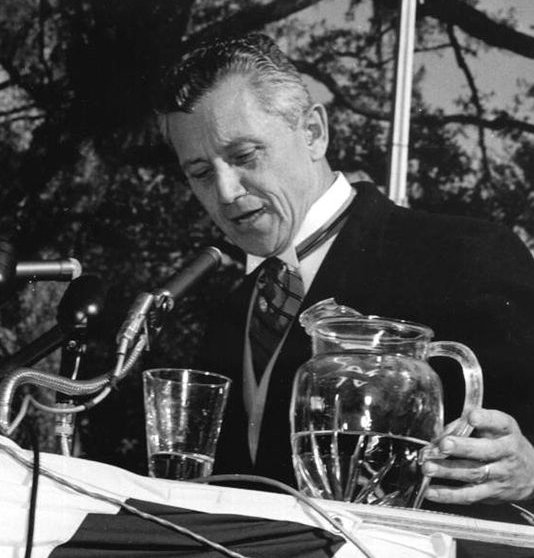 Photo: Florida Photographic Collection
After being elected Florida’s 33rd governor in 1954, upon the abrupt death of then Governor Daniel McCarty, he assumed office in 1955 and was reelected in 1956 to serve the first of two terms.
The landmark 1954 Supreme Court decision in Brown v. Board of Education, integrating public schools, settled into Florida during his first full term. While history reflects that he initially condemned the decision, in support of states’ rights, he fought with the Florida Legislature to try to prevent them from passing an “interposition” resolution.
This resolution would indicate the intent of the legislature to “interpose” itself between the citizens of Florida and the United States government to prevent what the legislature contended was an illegal intrusion upon the rights of the state by imposing integration.
Governor Collins referred to a provision in Section 10 of Article IV of the state Constitution (prior to the 1968 Constitutional revision) to unilaterally adjourn the legislature to prevent it from passing the resolution. After the legislature returned later, and passed the resolution, the governor had no power to veto it as it was not a Bill.
Instead of simply signing the resolution, he wrote his objection in his own handwriting for future scholars stating, in relevant part, “…if this resolution declaring the decisions of the court to be ‘null and void’ is to be taken seriously, it is anarchy and rebellion against the nation which must remain ‘indivisible under God’ if it is to survive…I decry it as an evil thing, whipped up by the demagogues and carried on the hot and erratic winds of passion, prejudice, and hysteria…” Absolutely fearless.
While governor, Collins was elected to Chair the Democratic National Convention and presided over John F. Kennedy’s nomination for the Democratic candidate for president in 1960.
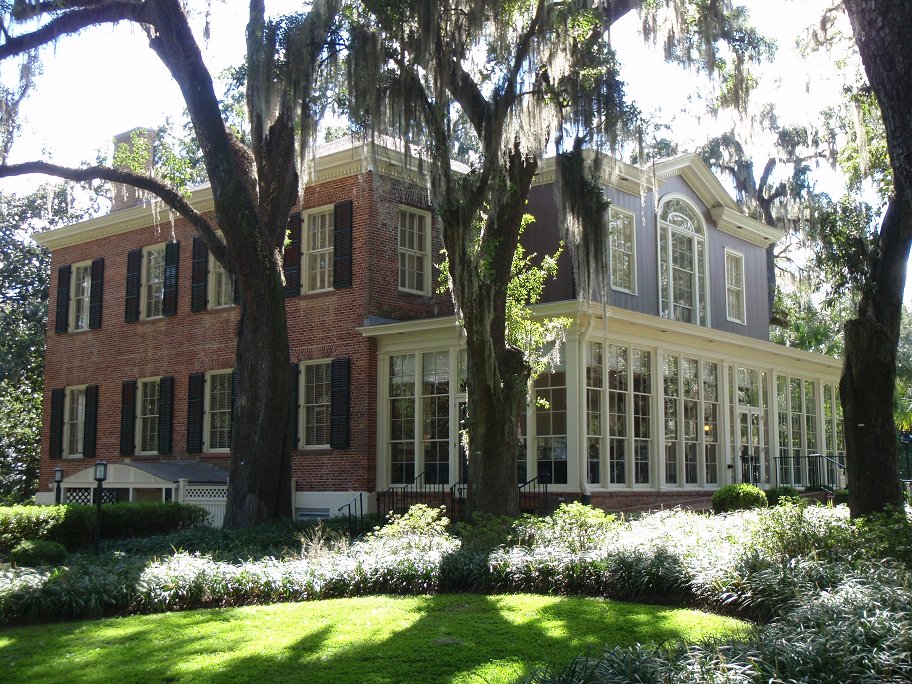 The Grove - Tallahassee, Florida - 2015
The expansive back yard of The Grove had countless places to hide and looking around I noticed Governor Collins sitting in the glass sunroom reading. It’s not always a good idea to be running around someone’s private property at night without their knowledge so I walked up to the sunroom and knocked on the door while shining my flashlight on my uniform. The governor answered the door with a gracious greeting just like something like this happened every night. After I explained the situation, and the risks, instead of disappearing into the house he got a flashlight and came outside with me.
And so, there I was with the two-term governor of Florida and Chairman of the Democratic National Convention who presided the year that John F. Kennedy was nominated for the Presidency, as my back-up. Fearless.
By the way, the suspect got away. I think it had something to do with my nosedive.
More information and pictures of The Grove and Leroy Collins.
|
| Remembering our First Famous Actress While Kathryn Reece Haun was not born here, she truly was a daughter of Tallahassee. Struggling to make her own way from a family of 9 children, she graduated from the Florida State College for Women, received scholarships to prestigious graduate schools, and found herself on Broadway and in films.
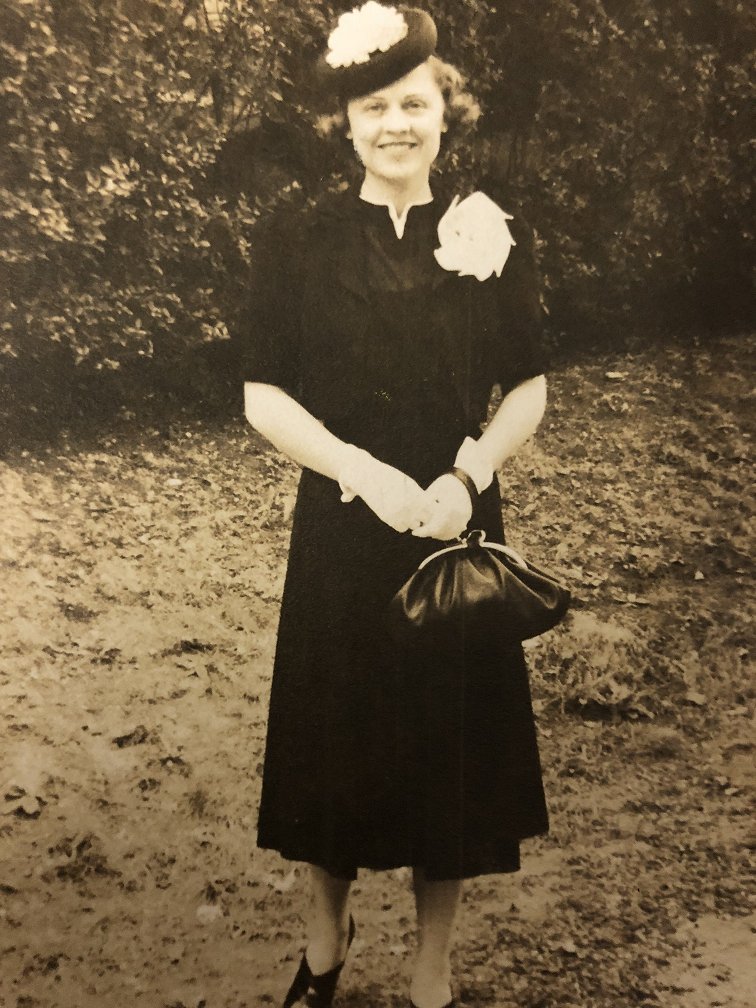 Kathryn Reece Haun (1899-1994)
Kathryn Reece was born in Ramseur, North Carolina, in 1899, graduating high school in Alabama in 1916. Her father, John William “Foddy” Reece, who was in the textile business, moved to Tallahassee in 1919 to open a Shuddle Block Mill on W. Gaines St. Their home was located at 529 West College Avenue. In time, Foddy also purchased 75 acres of farmland on the east side of town where the Inglewood and Reece Park Lane neighborhoods are now. So, how did a girl from a small southern town get all the way to Hollywood? For Kathryn, the road was long with years of study seasoned with hard work.
The Actor Develops
Kathryn attended the Florida State College for Women from 1919 to 1921. In 1921 she was crowned College May Queen the same year that her sister, Lucille, was May Queen at Leon High School. After receiving a degree in voice, her professor, Miss Emma Boyd, and the Dean of the School of Music, Miss Ella Opperman, arranged for a scholarship to the Cincinnati Conservatory of Music where she studied from 1921 to 1924. While in Cincinnati, she met Ewald Haun, a fluist, and they were married in Tallahassee in 1924 at her family’s home. In October, 1925, Kathryn moved to New York to study at the famous Julliard School of Music on a two-year scholarship.
Practicing her Talent
She made her Broadway debut at the Plymouth Theatre in April, 1926 as Phyllis in Gilbert and Sullivan’s “Lolantha.” The “Pirates of Penzance” followed in 1926 and the “Enchanted Isle” in 1927 where she was billed as the Grand Opera Star. Along the way, she performed in a series of Operettas in New York City. In 1927, she starred with the Marx Brothers in “The Cocoanut” in Los Angeles. “The Cocoanut” story line took place in Florida so the accent that she had worked hard to lose came naturally. Ms. Jean Revell, her niece in Tallahassee, recalled her relating the wild experience of working with the Marx Brothers who were as unpredictable off-stage as on.
In 1928, she sailed from San Francisco to Australia to perform for a year in various productions before returning to the United States in 1930 to star in the movie “Animal Crackers” with the Marx Brothers. Her husband died in 1939 but she trouped on performing all over the country during World War II.
In 1946, Kathryn returned to Tallahassee and taught voice lessons at her home at 624 North Calhoun St. After entering the real estate business in 1948, she developed the San Luis Ridge and Reece Park neighborhoods. In 1949, she once again returned to the smell of grease paint and the roar of the crowd by being a founding member of the Tallahassee Little Theatre where she served as Vice-President in 1950. Between 1949 and 1954 the fledgling Tallahassee Little Theatre actors presented performances in the former army movie theatre at Dale Mabry Field. In 1954 she moved into her parent’s home, at the old Reece farm, on Valley Road across the road from my Paternal Great Grand-Parent’s farm to care for her aging parents. Lynn Quinsey, her grandniece, remembers her in later years as an absolute goddess of grace and kindness.
Remembrances
When I was about 12, I mowed Ms. Haun’s expansive lawn on Valley Road. At the time, I thought that Ms. Haun was a piano or singing teacher. I had no idea that she was a famous actress that had traveled the world performing in the notable venues of the day and had been in movies. Her backyard was filled with flower beds that circled a fountain that had been fashioned from an old black iron molasses/scalding caldron. Being a typical 12 year old, I didn’t always get it done right but at least I was cheap. The backyard sloped down to a barn where livestock had been kept decades earlier. It was a creepy place overgrown with vines and kudzu with a small pond close by. I spent time in that barn, with other neighborhood boys, shooting our .22 rifles in the direction of a nearby pond. This dismayed Foddy who would occasionally watch unapprovingly from his wheelchair and stamp his cane on the ground in frustration. I thought he must have been 100 years old. As it turned out, he was only 99. I’m certain Kathryn thought me to be quite the scallywag.
Kathryn was not discovered in Schwab’s Drug Store in Hollywood like Lana Turner or had a fast-track due to connections. She achieved everything she accomplished through hard work, perseverance, and study. She truly was one of our Tallahassee pioneers.
|
| 1968 Brings Us Many Memories A speech by David Brand to his Leon High School Class of 1968 at their 50th reunion.
“They were the best of times, they were the worst of times…” Much like Charles Dickens wrote in A Tale of Two Cities, 1968 was fraught with challenges but glimmered with opportunity.
Following on the heels of what has been referred to as The Summer of Love in 1967, 1968 brought social unrest and tragedy but was also seasoned with the hope of the human spirit.
Remembrances
Dr. Martin Luther King, Jr. was assassinated on the porch of the Lorraine Motel in Memphis on April 4th. The frustration felt at peaceful assemblies segued into civil unrest in several cities including Tallahassee. A firebomb thrown into Crowe’s Grocery on Lake Bradford Road resulted in the death of Travis Crowe who was sleeping in his bedroom over the store.
Senator Bobby Kennedy, the frontrunner for the Democratic nomination for president, was shot and killed on June 5th in the Ambassador Hotel in Los Angeles where he had just completed a speech. Some historians believe that the magic world of Camelot, President John Kennedy’s favorite Broadway musical, died that day along with the Kennedy political dynasty.
The Vietnam war, with the first ground troops being sent in 1965, reached a turning point when North Vietnam forces launched the Tet Offensive on January 30th. The nightly news broadcasts resulted in a reappraisal of the mission and diminishing support in Congress. I was in the army in 1969 and visit the Vietnam Memorial Wall every time I’m in Washington D.C. representing the clients of the lobbyist firm that I work for. Some of our finest patriots are memorialized there. I am always humbled beyond words. As a 19 year old soldier, one of my memories is of the C-rations; the boxes of canned food that were a diet staple in the field. I often marveled at how the army could fly in a 15 cent can of Ham with Lima Beans by helicopter but I had to walk everywhere. As Forrest Gump said, “That’s about all I’ve got to say about that…”
Our teachers went out on strike in February due to underfunding of the state’s educational programs at a time when attendance was sharply rising and pay low. As a student, I completely understood their plight and the combination of audacity and frustration they must have felt to make this bold move. No additional funding came and most of the local unions settled their contracts and went back to the classroom by March. The 1968 Florida strike is considered the first statewide teachers’ strike in U.S. history. The Leon County School Board stepped up and arranged for both undergraduate and graduate students from FSU and FAMU to teach classes. Now, this became interesting. Overnight the Agnes Jackson types, with their wooden yardsticks capable of striking two rows back, were replaced by 21 year old Tiffany and Brittany sorts. I never missed a class.
On the upside, our schools were beginning to be integrated. Our new students, for the most part, kept to themselves as they struggled with how they would fit into the social life and culture of “Big Red,” the grand old school on the hill. It quickly became obvious that they were the best-of-the-best and excelled in both scholastics and sports. And then one day we had Mr. Julian Adderley as our Guidance Counselor. This long time Tallahassee resident and Florida A & M professor was the father of none other than Cannonball and Nat Adderley! Julian “Cannonball” Adderley was a jazz saxophone player who had played and toured with John Coltrane and Miles Davis. Nat, his brother, was a cornet player with a similar background. To an amateur saxophone player like myself, Mr. Adderley was a god! If I could go back and change anything about my high school years it would have been to broaden the circle of friends that I had. It would have enriched my life and strengthened by understanding of human nature.
In retrospect, Tallahassee was really a small town in 1968. We only had two movie theaters; the State Theater on College Avenue, and the Florida Theater on North Monroe St. The two outdoor theaters, on Apalachee Parkway and South Monroe St., were generally declared off-limits by the girls’ parents. I think it had something to do with those big car speakers that hung in the window damaging their daughters’ hearing but I could be wrong about that. I just can’t imagine myself nowadays sweating and swatting mosquitos while trying to watch a movie.
The movie “American Graffiti” could have been filmed on West Tennessee or South Monroe Streets. Cars cruised back and forth with the muscle cars, the Pontiac GTOs, Dodge Chargers, and Ford Mustangs, sniffing around each other must like stray dogs trying to establish the pecking order. On the peripheral were the Volkswagens and Ford Falcons, the Wannabes, circling the pack hoping to see some action. Then there was the outer perimeter; the Hopefuls. This was the younger set with their Vespa scooters and Honda Cub 50 motorbikes. Here the pegged denim and chino pants gave way to baggy jeans with rolled up legs and Buddy Holly black framed glasses. The Hopefuls, much like pilot fish, gathered closely waiting anxiously for a nod of acknowledgement from one of the cool guys. For the amateur racers, it usually went something like this. One of the “leaders of the pack” would be backed in at a drive-in restaurant; maybe McDonalds, Mutt and Jeff’s, or the Seven Steers on West Tennessee St. The Volkswagen Beetles and Falcons waiting patiently on the outskirts of the parking lot. A rival, or maybe even an out-of-town hotshot, would ride through, eye contact was made, and the race was on. A convoy would form, with the Beetles and Falcons pulling up the rear of course, and head out to one of the country roads for the race. Afterwards, providing there were no mishaps, everyone would return to the drive-in, hands were shook, stories were told, reputations reaffirmed, and even the little guys in the Falcons were allowed to join in. Thinking back, the potential for tragedy is difficult to measure. By the way, I had a Falcon.
Bill Chandler remembers the morning that fire ravaged Mendelson’s Department Store downtown in the Fall of 1967. Mendelson’s was a family owned department store that would be considered the equivalent of an anchor store in a shopping mall today. In business since at least the 1930s, it had two-stories and, with a quantum leap into the future, had a vacuum tube order and invoice delivery system within the store. The entire building burned to the ground with the fire spreading into the next building as well. This event was a turning point in the history of downtown Tallahassee and signaled the shift from shopping downtown to the Northwood Mall that would be built within the next two years.
Many of us, including Marcia Council Pearson, who attended Kate Sullivan and Elizabeth Cobb remember Virginia Gerber. A cute girl, athletic, and friendly with red freckles peppered across her nose. We needlessly and tragically lost Virginia the summer after the 7th grade. I never ride past Claude Pichard Drive without thinking about her. Virginia, you were not forgotten.
Nancy Carraway remembers not wanting to be labeled as “the awkward girl from Cobb who fell down a whole flight of steps on the first day of school.” The staircase at Leon was built by craftsmen from the CCC work corps when it was built in the late 1930s. As it descended to the first floor, the steps shortened and curved. Wearing a dress of course, the brand new 10th grader was skipping down the stairs only to get tripped up, scattering her books while rolling down the stairs bouncing off the walls and leaving a trail of belongings along the way. Fortunately, the only thing that was hurt was her self-image.
Norma Jean Greene, who was a majorette, remembers many of the trips and performances made by the band. Among these were the North Florida Fair Parade, Perry Pine Tree Festival Parade, FSU Homecoming Parade, Leon Homecoming Parade, May Party Celebrations, District and State competitions and, of course, the football games, pep rallies, and concerts.
Buddy Gridley’s favorite memory of the Class of ’68 would definitely be the 10-0 regular football season. Playing for Gene Cox, and all his assistants: Culbreath, Giles, Nellums, Thomas, et al, that brought us along for three years at Leon was a special blessing. Short of military combat, I can’t imagine anything that does a better job of turning boys into men or men into brothers than the game of football. Our goals were high and our practices brutal. Anyone who ever played for Coach Cox will attest to that. It was one of the happiest times of my life. To quote Thomas Paine, “The harder the conflict, the more glorious the triumph. What we obtain too cheap, we esteem too lightly!”
It all came together in Doak Campbell stadium when we thumped Gainesville High 40-7 for that 10th win. The guys on that team, some now gone to Glory, will always have a special place in my heart…every one of them! The cheerleaders and students that encouraged us were the best!
|
| Remembering Horrie Culpepper, Jr. and Rescue One Horrie Culpepper, Jr., who died at age 73 in 2003, was known about town for several reasons. While a childhood illness left him partially impaired, it did not stop him from a life of excitement and serving others.
Maybe guardian angels really do exist. For many Tallahassee accident victims of the 1950s through the 1980s, Horrie Culpepper may have fluttered over them just long enough to save their lives. The only child of Horrie and Lucille Culpepper, owners of Culpepper Construction Company, was stricken with encephalitis at an early age. While never completely overcoming the effects of that disease, it did not stop him from becoming an Eagle Scout, photographer, HAM radio operator, and most of all, an emergency service Volunteer.
Horrie’s real joy was patrolling in “Rescue One,” as he referred to his fully outfitted first-responder vehicle. Over the years it was either a Jeep or Chevrolet Suburban. State troopers, police officers, deputy sheriffs, and firefighters of that era would always recognize the arrival of Rescue One at accident scenes. With various antennas swinging back and forth and spotlights sweeping the area, Horrie would arrive, offer to help, and eagerly await an assignment even if it was something as simple as brewing coffee on one of the appliances that he carried onboard. Arranged neatly in the back were pry bars, helmets, flashlights, oxygen tanks, and flares that he was always eager to provide. Incredibly, he had the first expensive “Porta-Power” unit in Tallahassee; even before the fire department.
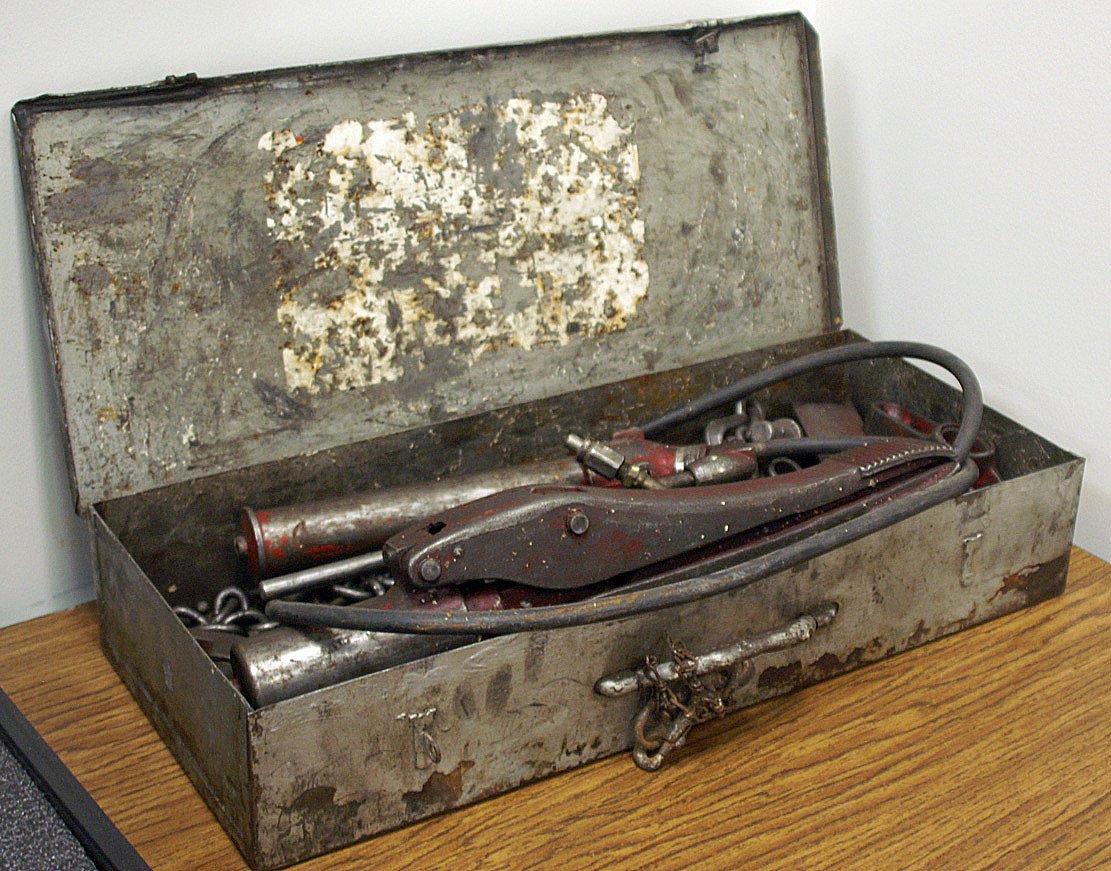 Horrie's hydraulic Porta-Power. These later segued into the "Jaws of Life" carried by fire/rescue units.
With this hydraulic device, firefighter/rescue personnel could pry open doors and bend the twisted metal of crashed vehicles enabling them to extract injured persons.
Radio scanners with every police and fire frequency sat by his bed at night so he could monitor the action. Rescue One, of course, was outfitted with the same radios. At one traffic crash, he ripped out a piece of the seat from his vehicle so a state trooper could use it as a backboard while removing an injured person from a car. But his care and concern didn’t end there. People that he had assisted at an accident scene would often get a visit from him if they were hospitalized.
As Tallahassee grew from a small town to a city, and security increased at law enforcement facilities, Horrie began to visit the various fire stations more frequently. On one occasion in 1970, he was visiting the fire department airport division when a twin-engine Cessna crashed on landing at the Tallahassee Municipal Airport. Horrie’s photo of the crash is now on file at the State Library and Archives of Florida.
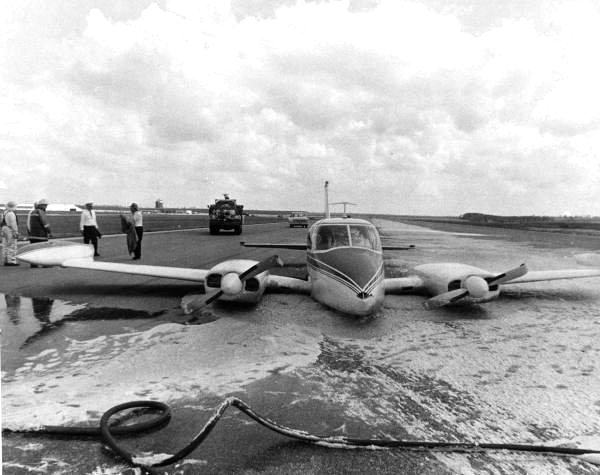 Airplane crash at the Tallahassee airport in 1970. - Photo taken by Horrie Culpepper.
Considered eccentric by some and perhaps a little frightening or intimidating by others because of his direct approach, he was not in the least mean-spirited and only wanted to be accepted and valued. He certainly kept me on my toes, reflected Ms. Virginia Thorne, a family member and his trust administrator. While his behavior could be challenging, his energy was always directed toward helping people.
As a young police officer in the early ‘70s, I was always grateful for his well-intended assistance. And then there were his stories! Because of his late-night ramblings, he was always encountering situations that he enjoyed talking about; maybe embellishing a little. Many of his stories focused on his “Cherokee Princess,” his imaginary girlfriend, based on a real person, who was always up to something. There was also the “C B Bandit;” his conjured petit criminal who prowled the night listening in on private citizens band radio conversations while plotting his next crime. Horrie could have been a writer for the old radio “Dragnet” series.
As our beautiful city continues to grow and change, I often think about the characters that make our home so unique and the lessons we learn from them. For Horrie, it was humility, being productive in the face of adversity, and service to others.
|
| Jim Morrison Walked Here If you want to go where Jim Morrison went you don’t have to visit the Pere Lachaise Cemetery in Paris where he is interred along with other poets and artists. You can stroll through some of our beautiful Oak tree shaded streets where he once walked and thought.
In the fall of 1963 It’s My Party by Lesley Gore, and Surfin’ U.S.A. by the Beach Boys topped the record charts. Kids were dancing to surf music on the west coast and the Shag on the east coast. Los Angeles and Myrtle Beach couldn’t have been more different but had one thing in common: dance music. It was an innocent time. It was a simpler time. Then came James Douglas Morrison who co-founded “The Doors” in 1965; one of the most influential and change agent bands of the 1960s that swept the music industry into the psychedelic age.
The Formative Years Jim, the son of Rear Admiral George Stephen Morrison, was born in Melbourne, Florida in 1943. Like all military families, they moved frequently until he went to live with his paternal grandparents in Clearwater to attend St. Petersburg Junior College. In 1962, he transferred to Florida State University. While attending FSU, Jim was described as a voracious reader, often quoting Friedrich Nietzche, the German philosopher and poet. It seems to be a reasonable assumption that it was about this time that he began to become the rebellious poet without a cause. After transferring to the University of California at Los Angeles in 1964, he received an undergraduate degree from the UCLA film school in 1965.
(Photo: Joel Robine, AFP/Getty Images) Living what could best be described as a bohemian lifestyle in Venice Beach, he co-founded “The Doors” taking that name from the title of Aldous Huxley’s book The Doors of Perception that described unlocking one’s perception using psychedelic drugs. While playing as the house band at the famous Whiskey-a-Go-Go in Los Angeles, the band exploded onto the scene with their break-out hit Light My Fire in 1967 eventually recording six studio albums. After a series of behavioral mishaps and arrests, Jim moved to Paris where he unexpectedly died in 1971. A brief but bright flash that changed music in the late 1960s. The Tallahassee Connection In the early ‘60s, student housing was limited. According to No One Here Gets Out Alive by Jerry Hopkins and Danny Sugerman published in 1980, Jim lived at different places including a trailer in the area of Palm Court, located off North Macomb Street, and an apartment in the area now occupied by the College of Law. His last known residence, in the fall of 1963, was in room 206 in the Cherokee Hotel. The Cherokee was formerly located on the southwest corner of East Park Avenue and South Calhoun Street next to the Park Avenue Chain-of-Parks.
The hotel was on the southwest corner of Park Avenue and Calhoun Street in Tallahassee. It was built in 1922 and demolished in 1964. (Photo: Florida Archives) Anyone who followed Jim’s life would surmise that he either had or at least displayed behavioral problems. Whether his behavior was unintentional, or the byproduct of a brooding artist is subject to debate however he experienced a series of arrests for what would best be described as nuisance offenses such as public drunkenness. He had been arrested five times for such offenses with the most severe being for indecent exposure during a concert in Miami in 1969. At least it was thought he had been arrested five times. In the late 1980s, intrigued by local folklore that Jim had been arrested while a student at FSU, Sergeant Phil Kiracofe, then the Public Information Officer for the Tallahassee Police Department, began to search for any documentation of an encounter. While rummaging around in some old dusty cardboard boxes, stored in the basement of the police department, he solved the mystery by locating the original booking card and mug shot where Jim had been arrested while attending a football game in 1963. This would have been his first known arrest for a total of six. On September 28th, 1963 Jim had been charged with Disturbing the Peace and petit larceny of a police riot helmet and umbrella from a police car. As one would imagine, a student wearing a trench coat and police riot helmet carrying an umbrella tends to stand out. This resulted in Captain Kenneth Causseaux taking him into custody.
(Photo: Special to the Democrat) Prior to the two-tier court system that we have now, the City of Tallahassee maintained its own city court for misdemeanors. As was the practice of the day, Jim was simply turned over to the FSU Dean the next morning. TPD still had the old box booking camera and metal letter board, that was held under the subject’s chin for identification, that was used for Jim’s photo. Of course, I had to have my photo taken with that camera holding the same letter board that Jim had. Just a tiny brush with fame. And so, you don’t have to go to Paris to see things that influenced Jim. You can stroll west on East Park Avenue and walk on the same sidewalk, see the same Oak Trees, and pass the same sights that probably influenced his lyrics. |
| Frank Stoutamire: Sheriff Without a Gun Frank Stoutamire was a well-known name in Florida law enforcement for decades. His career began as a deputy sheriff for five years under Sheriff Houstoun and continued when he was appointed Leon county sheriff by the governor in 1923 and was continuously reelected until 1953. Upon his retirement as sheriff, Tallahassee city manager Arvah Hopkins appointed him chief-of-police where he remained from 1953 to 1968. Over his 50 year career he never carried a holstered gun.
Frank Stoutamire
In the 1920s, Tallahassee was little more than a small village. Florida State College for Women, the predecessor of Florida State University, had become a prominent place of higher education for women. Florida A&M University was a driving force for both the culture and economy. State government was small with the legislature meeting only once every two years. On the north side of the county were large plantations owned mostly by northern industrialists who traveled here to hunt quail and entertain guests. Agriculture and timber dominated the local economy with townsfolk riding horses and buggies into town for supplies.
Leon County sheriff years
In 1923, Governor Cary Hardee removed Leon County Sheriff Jim Bob Jones, along with the incumbent county judge, for improperly using jail inmates to work for private business. It seems they had some sort of “Shawshank Redemption” thing going on. Frank Stoutamire, who at the time was a Tallahassee city commissioner, simply walked to the Capitol and asked the governor for the job.
When he took office, Sheriff Stoutamire only had two deputies. He frequently rode horseback by himself to Miccosukee to serve civil writs, spending the night there. The next morning, he would circle back to the Chaires community and then on to Woodville. This circuit would typically take three days.
Photo of Frank Stoutamire’s Stetson hat provided by his granddaughter, Beth Bloomquist.
In the 1930s, gangsters such as John Dillinger and the Ma Barker gang were making headlines across the country. Sheriff Stoutamire had an encounter with another Depression-era group of bank robbers in Tallahassee. Members of the Blackie Thompson gang were committing robberies in Oklahoma, Texas, and Florida. The sheriff received information that the gang was going to rob the Capital City Bank and staked it out along with Tallahassee police officer Barney Gatlin. On January 29th, 1934 two escaped Oklahoma convicts, who were members of this gang, their wives, and a third subject were taken into custody after a car chase that ended when Officer Gatlin shot out the suspect’s car tire. $10,000.00 in bonds and $4,200.00 in cash were recovered from a previous robbery. A fortune during the Great Depression.
The police chief years
After retiring as sheriff in early 1953, the Tallahassee city commission unanimously appointed him chief-of-police after being recommended by city manager Arvah Hopkins where he remained until his retirement in 1968. Those 15 years saw many historical events beginning with the “I like Ike” era of the President Dwight Eisenhower administration and cold war through the civil rights movement of the 1960s and tragic deaths of Senator Robert Kennedy and Dr. Martin Luther King, Jr. in 1968. All of these events had an impact on Tallahassee.
In the 1950s an effort was made to raise the standards of law enforcement and the Florida Police Academy was established. In 1954, under Chief Stoutamire’s leadership, every Tallahassee police officer attended this academy.
Of course, his 50 year career was not without some minor controversy. In 1957, a local attorney said that he observed a restaurant employee going to the back of the police station and receiving eggs that had been brought in from Chief Stoutamire’s 500 acre farm on Highway 20. It was further reported that the same attorney had to step aside on another occasion when a prisoner was delivering eggs from a double-parked police car to a restaurant. The chief responded that on as many as a half-dozen occasions eggs had been delivered to a café or grocery by a prisoner that was doing janitor work at the police station.
Remembrances
When I was a young Tallahassee Police motorcycle officer, several years after he had retired, I remember Chief Stoutamire driving around town in his Plymouth wearing his signature beige Stetson hat. He would frequently have breakfast at the F&T restaurant on South Monroe Street and on more than one occasion would flag me down for a quick chat about police goings on. He was always a gentleman and an avuncular figure to me. At the time, I didn’t realize that I was talking to walking history.
Some of Beth Stoutamire Bloomquist’s fondest memories of her grandfather, or “Pop” and “Dude,” as she referred to her grandfather and grandmother, were the huge family Christmas breakfasts at his home at 402 South Bronough Street where they would have Bradley’s sausage before it was sold commercially. The R. A. Gray Building is now on that site. She also relishes the memories of him reminiscing about life on the family farm where they smoked hams, sausages, and rode horses. And then there were the frequent visits where he would play Chinese checkers with her at her home. While Beth and I are the same age, I remember Frank as a lawman and she, of course, remembers him as a loving grandfather who never wore a gun.
Frank Stoutamire was a law enforcement pioneer who was at the top of two law enforcement agencies that would be later recognized as world class organizations. I wonder if we will ever see anything like that again.
|
| Cannonball Adderley: Tallahassee Jazz Pioneer
In Tallahassee, in the early 1940s, one might have heard Glenn Miller’s “In the Mood,” or Frank Sinatra crooning a love ballad on the radio. But, if you were in the right place you might have heard Julian Adderley and his brother Nat playing the saxophone and cornet live. Julian Adderley, Jr., or “Cannonball” as he was professionally known, was one of our most famous jazz musicians. He got there by having great parents, a solid education, and checking all the boxes along the way such as a stint in the Army and as a high school teacher.
Early Tallahassee
While he was born in Tampa in 1928, Julian’s family moved to Tallahassee when he was young. His father, Dr. Julian Adderley, Sr., and his mother, Jessie, were educators and had obtained teaching positions at Florida A & M University. As a cornetist himself, Dr. Adderley instilled a love of music in his sons Julian, Jr., and Nat. By the time Julian was 14, he was playing with his own band at local venues in the historic Frenchtown section. By one account, he played with the great Ray Charles here before either were known.
After graduating from FAMU in 1948, Julian became a high school band director at Dillard High School in Fort Lauderdale. Uncle Sam called in 1950 and he was drafted into the U.S. Army where he became the leader of the 36th Army Dance Band.
The Big Apple
With his military service over, he moved to New York City in 1955 planning to pursue graduate studies in Manhattan. However, one night his destiny changed after finding his way into the famous Café Bohemia in Greenwich Village accompanied by his brother Nat, a cornet player like their father, and was asked to sit in for the band’s regular saxophonist. The Café Bohemia was considered the mecca for finger-snapping jazz and progressive music conception. At the end of the evening, the manager called out to Nat “Who is that guy?” Nat shouted back, “Cannibal!” which was a nickname he had been given because of his ferocious appetite. The manager misunderstood and introduced him as “Cannonball” to the jazz patrons. The name stuck. Shortly thereafter, he began to be referred to as the next Charlie Parker, who died earlier the same year, and was later immortalized in the movie “Bird” directed by Clint Eastwood.
Not unlike most musicians, Cannonball was involved with different bands performing with other fledgling performers such as John Coltrane, Miles Davis, and Sarah Vaught for the next few years. Along the way, he made his coast-to-coast television debut on NBC’s the Tonight Show, hosted by Steve Allen, in July, 1956.
Performing with Nat
In September 1959, Cannonball reunited with Nat and formed the Cannonball Adderley Quintet. The quintet recorded live one month later at the San Francisco Jazz Workshop and became an immediate success. For the next 16 years the quintet performed in venues all over the country. Cannonball’s personality also played a role in making the band popular. He loved to interact with the audience with commentary that explained the music. According to the New York Times, he once said, “I prefer nightclubs to concert dates because I dig the sound of laughter, the murmur of the crowds and that cash register – there’s something Freudian about the ringing of a cash register. I feel that when people pay to hear music, I owe them something.” One of Cannonball’s most famous record albums was “Mercy, Mercy, Mercy! Live at the Club” recorded in 1966 and received the Grammy Award for the best instrumental jazz performance in 1967.
Cannonball recorded 55 hits as the band leader, seven with his brother Nat, and 25 with other greats such as Sarah Vaughan, Dinah Washington, and Miles Davis.
Back home
Even after becoming nationally known, he took time to return to Tallahassee to perform at FAMU’s Lee Auditorium in February, 1957 at a benefit for a fraternity scholarship fund. Tallahassee was his home. Though widely traveled, he visited his family often. First at their home on West Pensacola Street, where the FSU law school is now, and later on Young Street near FAMU campus. Sadly, Cannonball passed away after suffering a cerebral hemorrhage while performing in Gary, Indiana on August 8th, 1975 at the age of 46. He is buried in Tallahassee at the Southside Cemetery.
At the beginning of my senior year at Leon High School we had a new guidance counselor, Dr. Julian Adderley. I was a saxophone player, albeit a bad one, so he was like a god. On the few times I interacted with him I was completely in awe and could barely speak. He was an experienced educator, used to dealing with kids, so instead of just staring at me like I had two heads he gently coaxed the responses he needed.
Cannonball, you are remembered and missed. You did us proud!
|
| General Jonathan Wainwright: Hero of Bataan had Tallahassee Ties
On September 2nd, 1945, U.S. Army Lt. General Jonathan M. Wainwright, later Four Star General and Congressional Medal of Honor Awardee, was present aboard the USS Missouri in Tokyo Bay when Japan signed the instrument of surrender ending World War II. Born in 1883, General Wainwright was from a long line of military officers. Following the family tradition, he attended West Point graduating in 1906. 35 years later, he was the U.S. 4th Army Commander in the Philippines when the U.S. entered World War II. On February 22nd, 1942, President Franklin Roosevelt ordered General Douglas MacArthur, who at the time commanded all Pacific forces, to leave the Philippine capital of Manila ahead of the Japanese invasion and relocate in Australia. This resulted in Wainwright becoming the senior field commander of the U.S. and Philippine armies, consisting of about 16,000 troops, and being tasked with defending the islands. The Philippines were an isolated archipelago for the U.S. but a mere stepping stone for the Japanese in their efforts to obtain oil and rubber to sustain the war. Given the loss of much of the U.S. Navy fleet at Pearl Harbor, the United States developed a Europe first strategy. The logic being we could ship soldiers and supplies across the Atlantic to England but not across the vast Pacific to the far East. The Philippines were left on their own with the battle continuing for several months with U.S. troops facing starvation and disease. General Wainwright fought alongside his soldiers and was often seen carrying a rifle himself. On March 28th, Wainwright advised the War Department that food stocks on Bataan would be exhausted by April 15th. The Philippines fell on April 9th but Wainwright and the combined forces escaped to Corregidor Island and retreated into the Malinta Tunnel, a fortress the U.S. Army had carved out of a mountain in the 1930s. General MacArthur, who fancied himself soon returning as a conquering hero to liberate his beloved Philippines, ordered Wainwright not to surrender. General Edward P. King, Jr., serving under Wainwright and understanding the pressure being placed on his superior officer and with his troops starving and malaria ridden surrendered to the Japanese. The surrendered troops were then forced to march 65 miles up the Bataan peninsular to San Fernando. Thousands died from starvation and being bayoneted by Japanese soldiers if they fell behind. The survivors were then taken by rail to POW camps where thousands more died. In February, 1945, U.S. forces retook the Philippines. Two weeks after being liberated from the POW camp in August, 1945, General Wainwright stood along with General MacArthur when the Japanese signed the instrument of surrender aboard the USS Missouri in Tokyo Bay. In September, 1945, he was promoted to four star general and awarded the Congressional Medal of Honor by President Truman. After returning to the U.S. he toured the country receiving a hero’s welcome. After the war, General Homma Masaharu, commander of the Japanese invasion forces in the Philippines, was held responsible for the death march by an American military tribunal and executed by firing squad on April 3rd, 1946.
General Wainwright visited Tallahassee in 1947, shortly before he retired from active duty for a courtesy visit with Governor Millard Caldwell and other political luminaries. He also had numerous family members here. The Wainwright family, with roots going back several generations in Tallahassee as well as Bradford and Union counties, were involved in and had ties to Florida government and politics. While in Tallahassee, the general had dinner one evening at the Floridan Hotel. The guests included Ms. Marian Wainwright Lambeth’s grandparents, William and Blanche Wainwright. Marian’s father, William, Jr., described the general as being very humble and related a story about how the general, during the Bataan Death March, was offered to ride with the Japanese commander but refused opting to remain with his soldiers.
In what now seems like a different lifetime I was a soldier; just another teen-age infantry grunt. I had a Filipino-American platoon sergeant who was a small man; only about 5’5” and maybe 150 pounds. While mellowing in the twilight of his career, he still reminded me of a coiled snake ready to strike without warning. One afternoon, he related the story of the siege of the Malinta Tunnel and the infamous Bataan Death March. While he never mentioned if he was among the survivors, I suspect that he was. This awesome old soldier had been awarded the Combat Infantryman Badge with two stars. This meant he had served in combat in three wars; World War II, Korea, and at least one tour in Vietnam. I later learned there had only been 325 of these two-star CIBs awarded; fewer than the Congressional Medal of Honor. He loved his adopted country and had made sacrifices that most of us can’t imagine.
Mabry Manor is a neighborhood located in southwest Tallahassee. It was named after Dale Mabry Field, the nearby U.S. Army Air Corps Field during the war. Two of the streets are named MacArthur and Wainwright. They intersect much like the lives of the two generals.
|
| Mystery at the Mansion
On October 5, 1944, 17 year old U.S. Army fighter pilot Lt. Joseph Azat took off from Assam, India with a flight of four P-47 aircraft for a patrol over Burma. He, along with two other pilots, were lost in action. In 2011, 67 years later, his dog tag was found buried in an underground water cistern behind The Grove in Tallahassee.
The youngest pilot in the U.S. Army Air Corps
Lt. Azat enlisted in the U.S. Army, with an altered birth certificate, in 1943 and was accepted into the pilot cadet program later that year. Born on March 27, 1927, in Wilkes-Barre, Luzerne County, Pennsylvania, he was only 15 years old.
He received his basic and advanced flight training at Marianna, Bainbridge, and Eglin Field in the panhandle. Afterwards, he was assigned to the 10th Air Force, 58th Fighter Squadron, 33rd Fighter Group in the Pacific Theater of operations for a relatively short period of time in the fall of 1944 making him, at age 17, the youngest pilot in the U.S. military.
On October 5, 1944, Lt. Azat, service # 0-820195, took off from Assam, India in his P-47D fighter for a patrol “over the hump” to Burma (now named Myanmar) along with three other aircraft. The weather was cloudy and the flight had difficulty maintaining visual contact with each other. When they broke out of the clouds on the Burma side of the mountain pass, the flight leader had lost sight of two of the aircraft with only Lt. Azat in view. Lt. Turner, the flight leader, made a 180 degree turn attempting to locate the two missing aircraft. Upon completing the turn, he had lost Lt. Azat as well. Lt. Azat’s wreckage and body were not recovered.
The Grove
The Grove, officially known as the Call-Collins House, is now a State of Florida museum located at the intersection of North Adams Street and West 1st Avenue in Tallahassee. Territorial Governor Richard Keith Call constructed The Grove around 1840. The construction was accomplished by highly skilled enslaved craftsmen. Around 1851, Call deeded the property to his daughter, Ellen Call Long who owned it until 1903. After a succession of other owners, future Governor LeRoy Collins and his wife, Mary Call Darby Collins, a great-granddaughter of Richard Keith Call, bought it.
According to Mr. John Grandage, Director of Public Engagement and Historic Site Development, Florida Department of State, Mr. Collins joined the Navy as an intelligence officer in 1944 and briefly moved his family to the west coast for the duration of War World II. During this time, Robert Aldridge became the caretaker of the property. After the war, LeRoy Collins returned to Tallahassee and practiced law. In 1954 he was elected the 33rd governor of Florida and served from January 4, 1955 to January 3, 1961.
From 1955 until 1957, The Grove served as the governor’s mansion while the current residence was under construction. The State of Florida acquired the property in 1985 to create a museum. The Collins family received a lease that allowed them to live there until their deaths. After Mrs. Collins died in 2009, the property formally reverted to the State of Florida. In 2011, while undergoing extensive renovations, the buried cistern was unearthed.
The mystery and unsupported speculation
While excavating the cistern, workers retrieved bottles, old toys, and other assorted rubbish that had been used to fill the cistern that was buried 15 feet deep on the grounds of the mansion. One intriguing item found was Lt. Azat’s dog tag. It should be noted that one of Governor Collins’ dog tags was also found in the cistern. Another unexplainable mystery given that dog tags are generally considered a keepsake.
Dog tags are the informal name given to the personal identification tags worn by U.S. military personnel dating back to the civil war. While a necessity, if not somewhat macabre, personnel were issued two tags. In the event of death, the tag with the longest chain was left on the body and one with a shorter chain was removed from the body and retained by ranking personnel to document the death. Only one of Lt. Azat’s dog tags was found in the cistern.
And so, how did the dog tag of a fighter pilot killed in action half way around the world find it’s way into an old water cistern in Tallahassee?
Both Governor Collins and Lt. Azat spent time at The Presidio, a former Army base now a National park near San Francisco. However, the probability of them meeting is remote given that Lt. Azat was not from Tallahassee.
Another possibility is that Lt. Azat may have trained at Dale Mabry Field in Tallahassee. Formerly located in the area of Tallahassee Community College, Army pilots received advanced training in P-47 and P-51 aircraft there. If the dog tag was lost while training, there is still no explanation of how it came to be in the cistern.
The most likely scenario, according to Director Grandage, involved parties for servicemen that were hosted at The Grove during the war. While there is no record of Lt. Azat being stationed at Dale Mabry Field, it’s possible that he could have been present at one of the parties, the dog tag somehow lost on the grounds, found by someone, left in the house, and eventually thrown into the cistern by an unknown person.
The Florida Department of State located a family member of Lt. Azat, Ms. Caprice H. Ryman in Kingston, Pennsylvania, and gave the dog tag to her. She had no clue how it wound up buried in the back yard of The Grove.
The mystery of the dog tag may be with us forever.
|
David Brand's ![]() e-mail
e-mail
